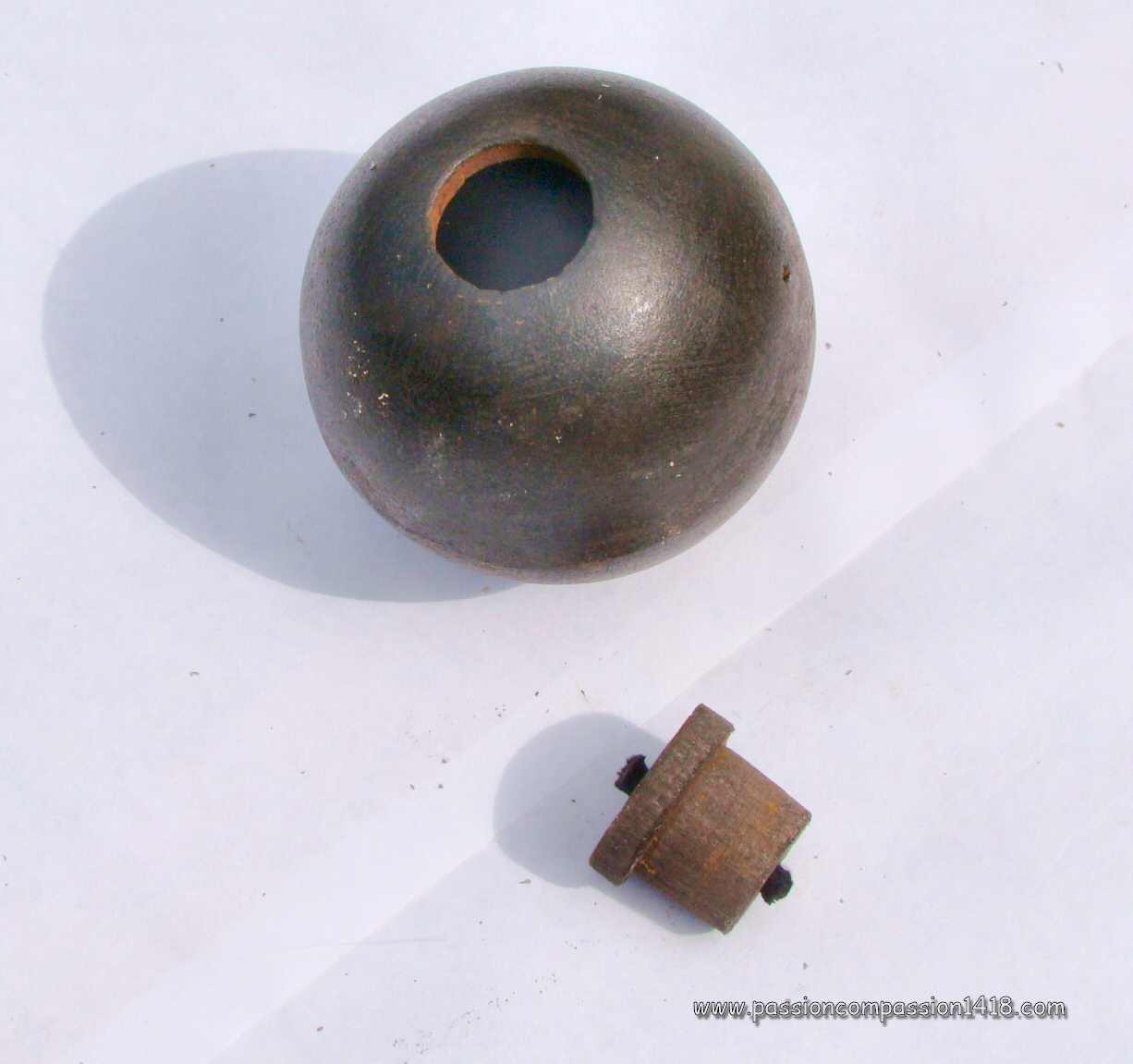IIIrd Army grenade
Pétard de la IIIe Armée de 12.5cm x 3cm
|
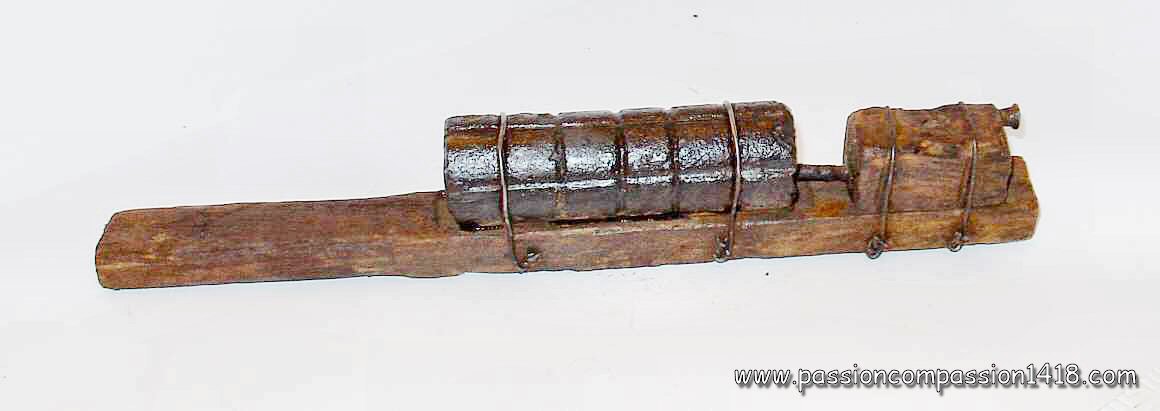 |
The grenade of the IIIrd army
(‘grenade de la troisième armée’) is an industrialization of the improvisations of the first months of the war (the famous 'pétards' or 'hairbrush grenades', composed of a wooden paddle, cheddite reglementary charge, and nails, gravels or steel wire) , made necessary by the low capacity of the French military material department to develop and manufacture more modern models of grenades quick enough for the urgent needs of the fighters.
More a firework than a real grenade, it is a prefragmented steel tube 12.5 cm long, which internal diameter (3 cm) is designed for the insertion of a conventional mélinite 100 gr. cartridge model 1890 with a detonator in its center.
The first models were triggered by igniting a 5 seconds wick connected to the detonator. That system was soon improved by igniting the wick with two hunting ammunition staters placed in a smaal wooden block. The starters were triggered by a percussion on a nail introduced into a hole of the wooden block, pressing on a small metallical piece connected to the starters base.
Several (5) cylinders models existed of the same size, and this device were to be used until 1917 (the cheddite explosive replacing the mélinite), each time that the demand exceeded the industrial capacity for modern grenades.
Approximate weight 550 gr., including 100 gr. of cheddite or melinite
|
IIIrd army grenade. General view of this rather primitive weapon, used until 1917 ! |
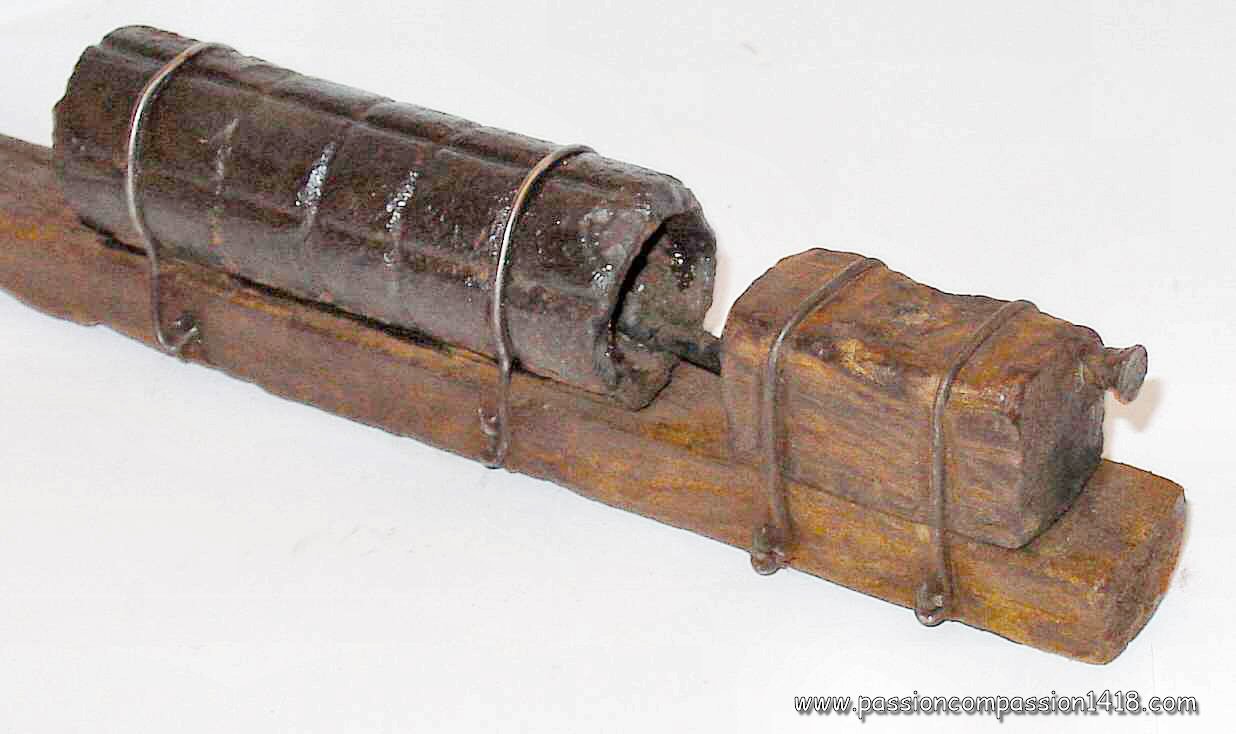 |
IIIrd army grenade - detail on the wooden block with the percussion nail on the top and the nick getting inside the cylinder |
|
|
Return at the top of page |
Barbed wire destruction rod
Pétard de destruction pour barbelés (400 and 800g cheddite)
|
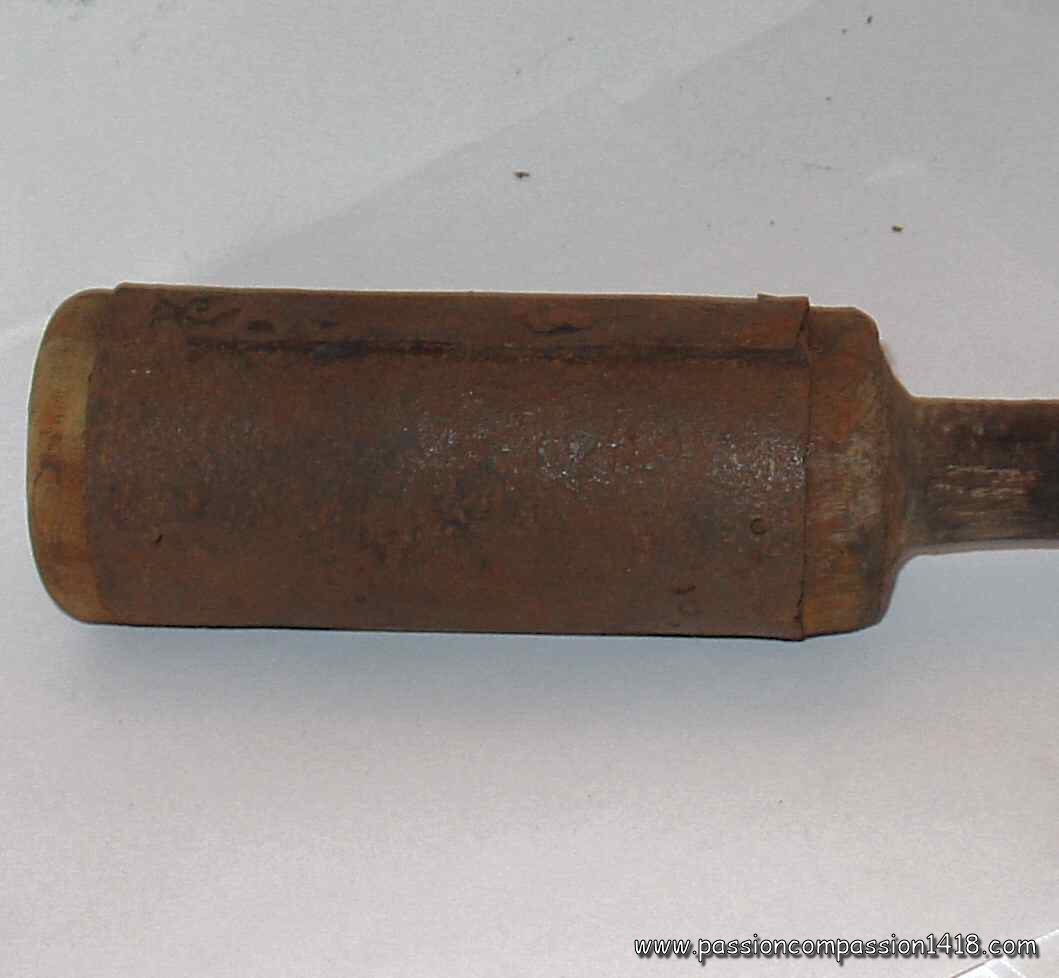 |
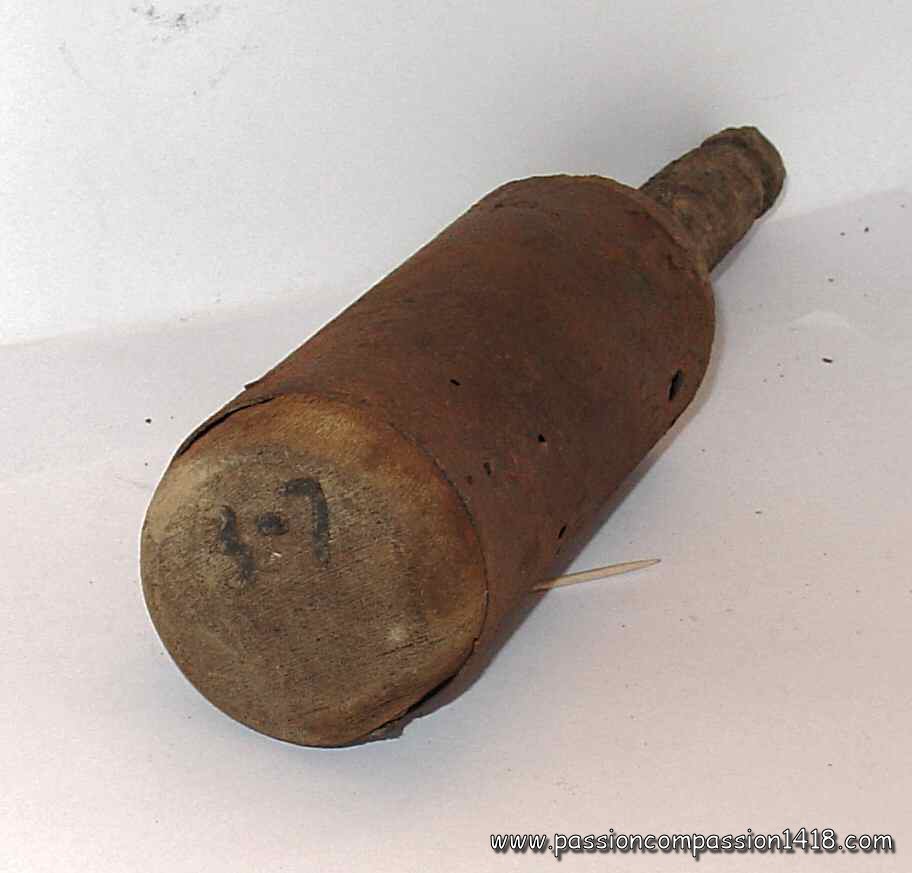 |
The explosive rod for barbed wire destructionis a variety of the original improvisated wood rod grenades, dedicated at the beginning of the war for the creation of breeches in the barbed wire networks before the assaults.
Having quite a primitive conception, it is simply a cylinder made with a rolled anb riveted steel plate, plugged at the top with a wooden block, and at the base with a wooden stick . This stick was hollow, making place for a traction igniter setting fire to a powder line cord (representing a 5 seconds delay), linked to the detonators. Those latter cause the explosion of the 400 gr of Cheddite charge, confined in the steel cylinder.
A new model with a doubled explosive charge (800 g), longer, appeared in 1916.
Approx. weight 600 g, including 400 g cheddite (800g on new models)
|
Explosive rod for barbed wire destruction - detail showing the rolled steel plate |
Explosive rod for barbed wire destruction - detail showing the top woode cover, with the engravings '3-7', meaning delay from 3 to 7 seconds, nominal beeing 5 seconds... not very precise... ! |
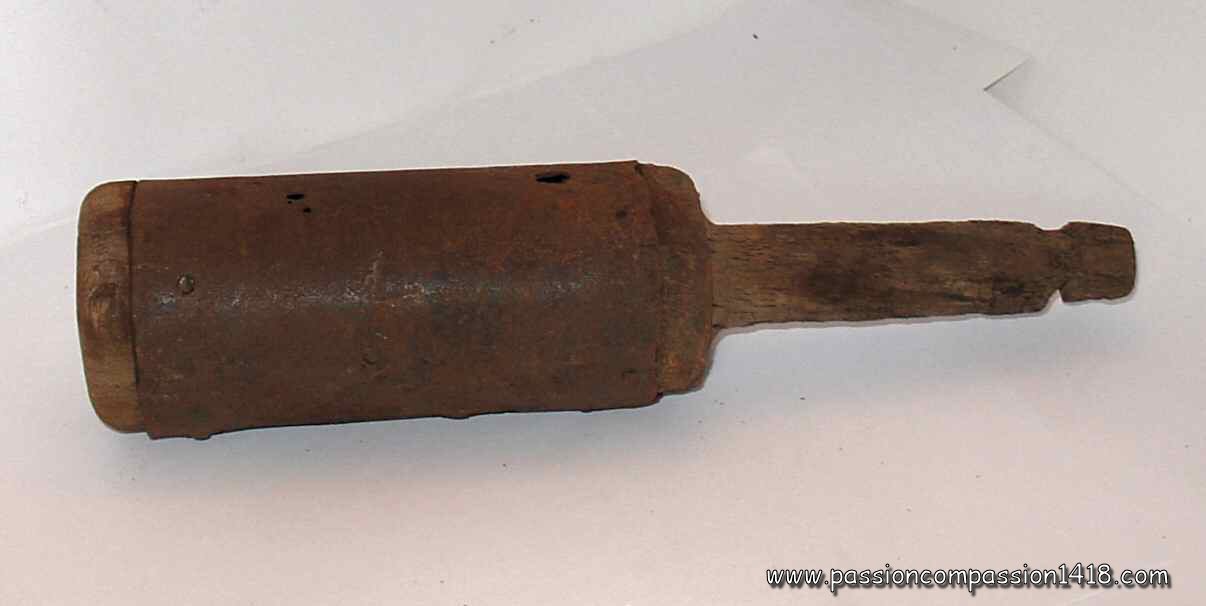 |
Explosive rod for barbed wire destruction. General view of the 'small' 400g cheddite model |
|
|
Return at the top of page |
Ball grenade model 1847
Model 1847 grenade
|
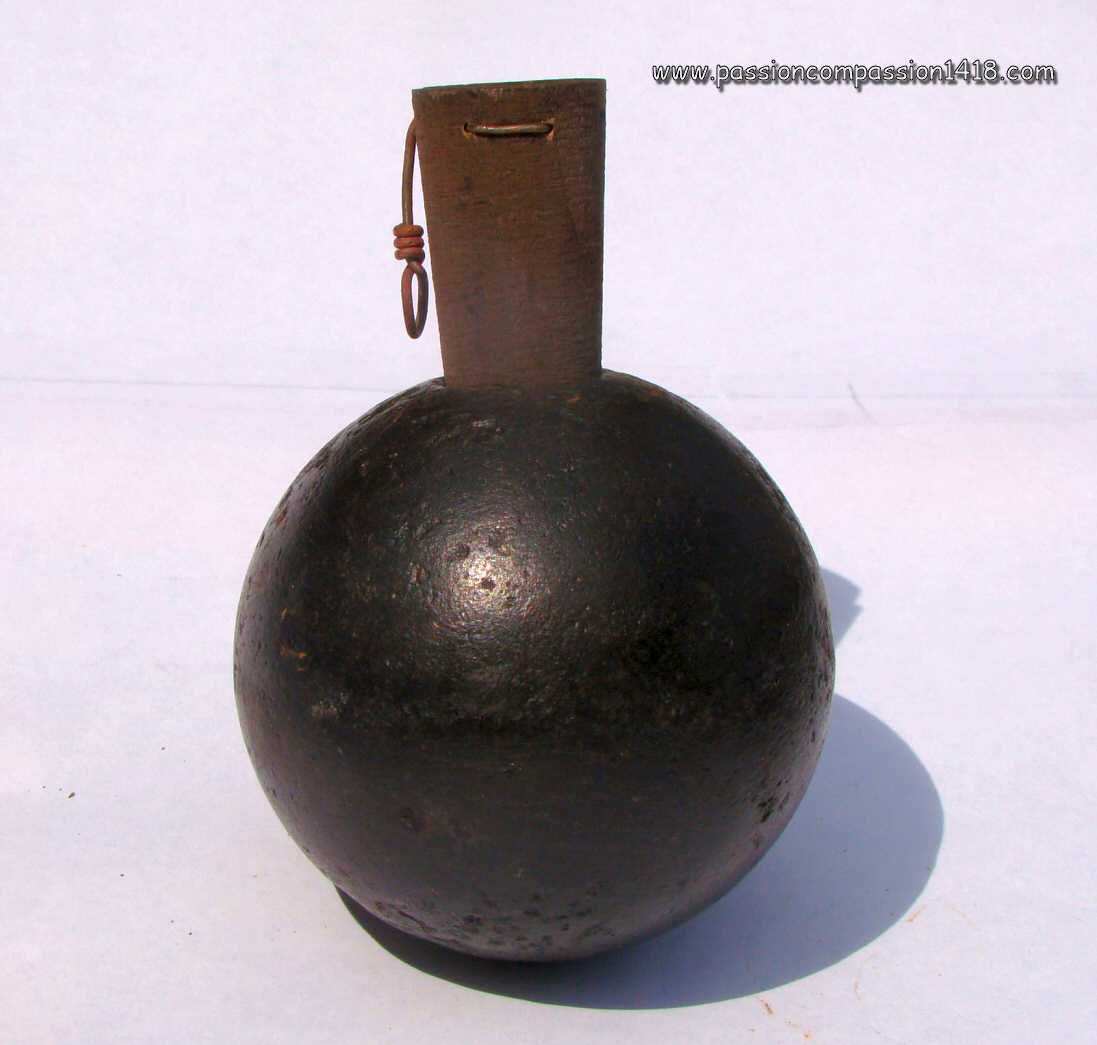 |
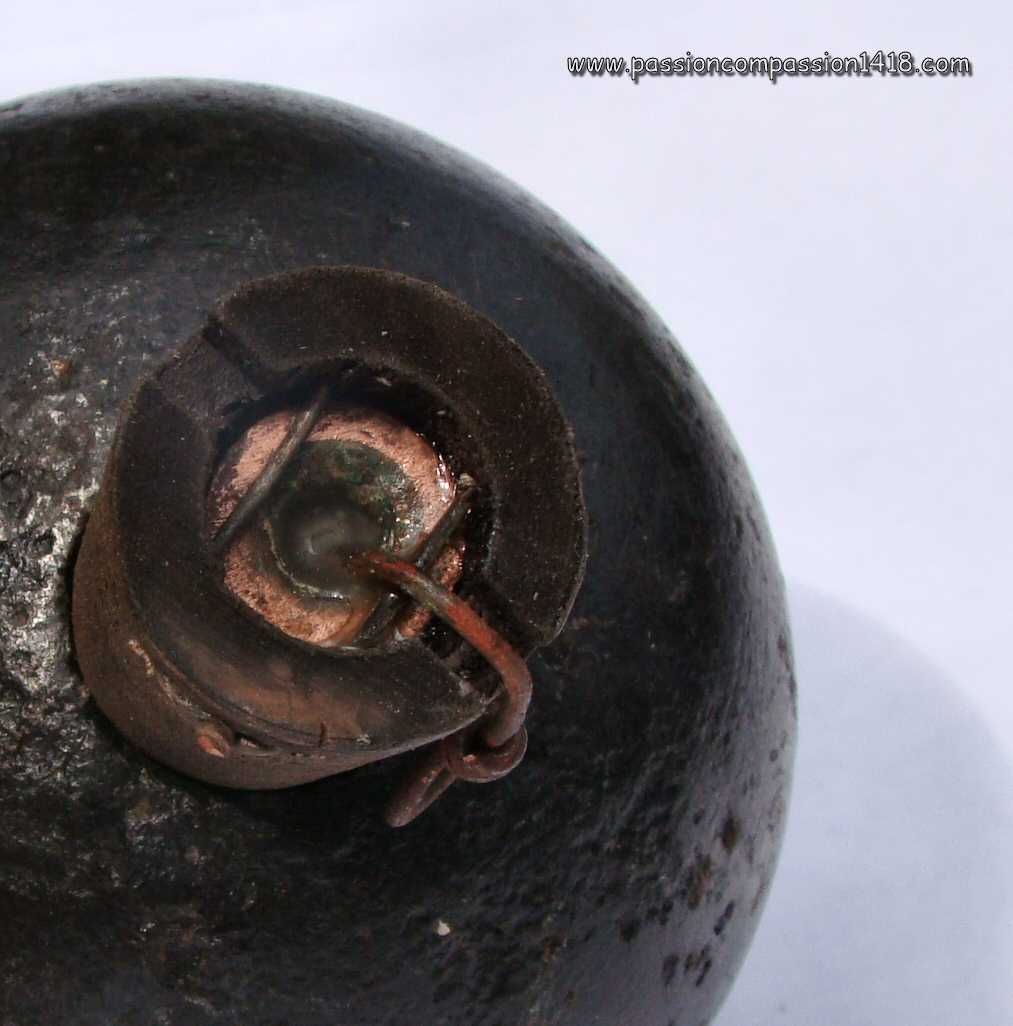 |
Almost as old as the invention of the black powder, the grenade was stantardized in France by Gribeauval in 1777 under the shape of a 9.5 cm diameter pig iron hollow sphere drilled with a smooth hole for the insertion of a wood plug with a wick inside ('fuze').
In 1847 the size of the sphere was reduced in order to reduce the weapon weight (1kg200 instead of 1kg900). In 1876 a slightly less rudimentary fuze was introduced, with a traction igniter to replace the direct firing of the wick, and finally in 1886 came a new version, a little bit more waterproofed.
The assembly of this sphere designed centuries ago and modernized for the last time 67 years ago, with a antique fuze whose last improvement had been made about 30 years ago, formed the only official grenade at the disposal of the French soldiers in 1914 : the grenade modèle 1847.
This grenade, equipped with a 5 seconds delay, was launched by hand, the traction igniter wire being attached to a rope linked to the launcher's wrist. In these conditions, the grenade range was rarely over 20 meters. It was possible to add 50 meters to this range by using a sling.
Weight 1.2 kg, including 110 g black powder
|
Ball grenade model 1847, with its wood fuze model 1886 : a weapon from other times... |
Ball grenade model 1847, detail of the fuze hole with the traction igniter loop |
 |
 |
Fuze modèle 1886, lower view |
Fuze modèle 1886, lateral view |
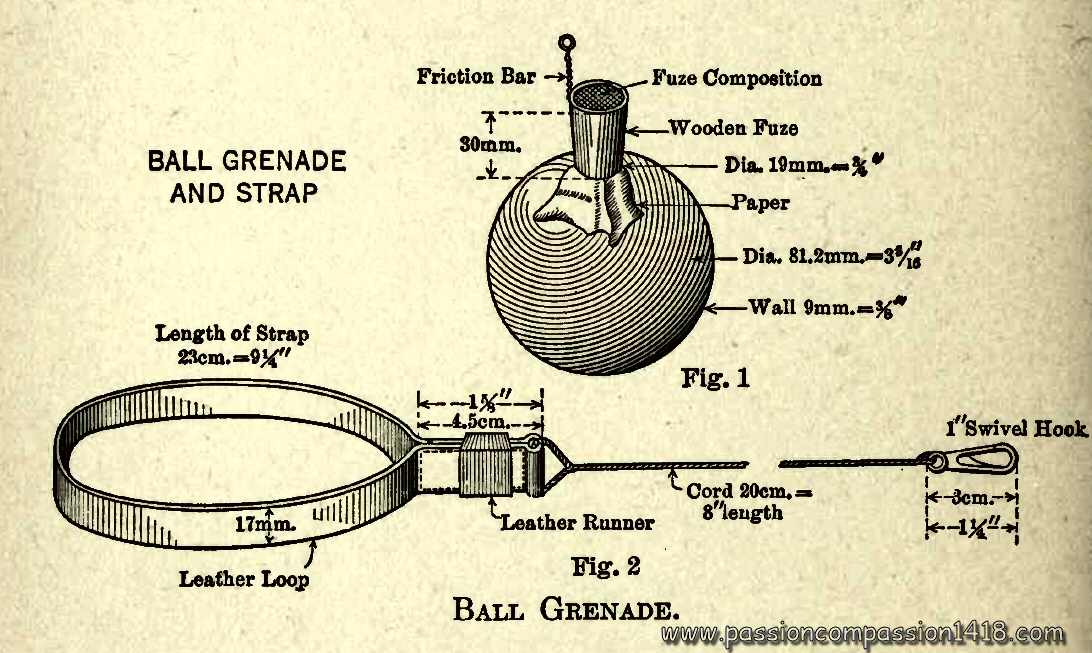 |
Ball grenade model 1847 - wartime scheme |
|
|
Return at the top of page |
Ball grenade model 1914
Model 1914 grenade
|
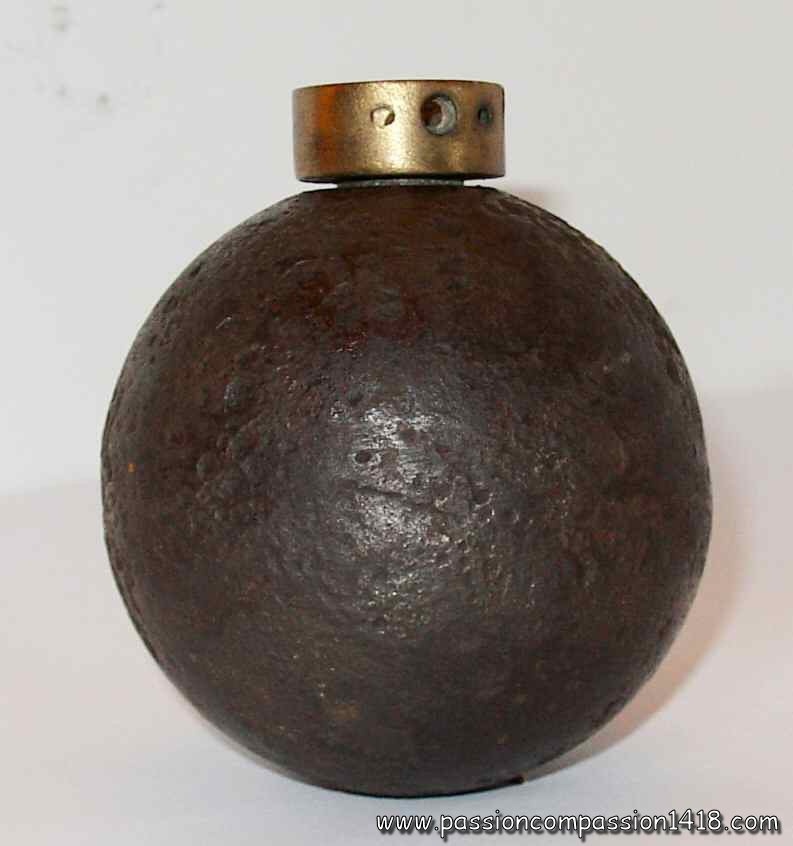 |
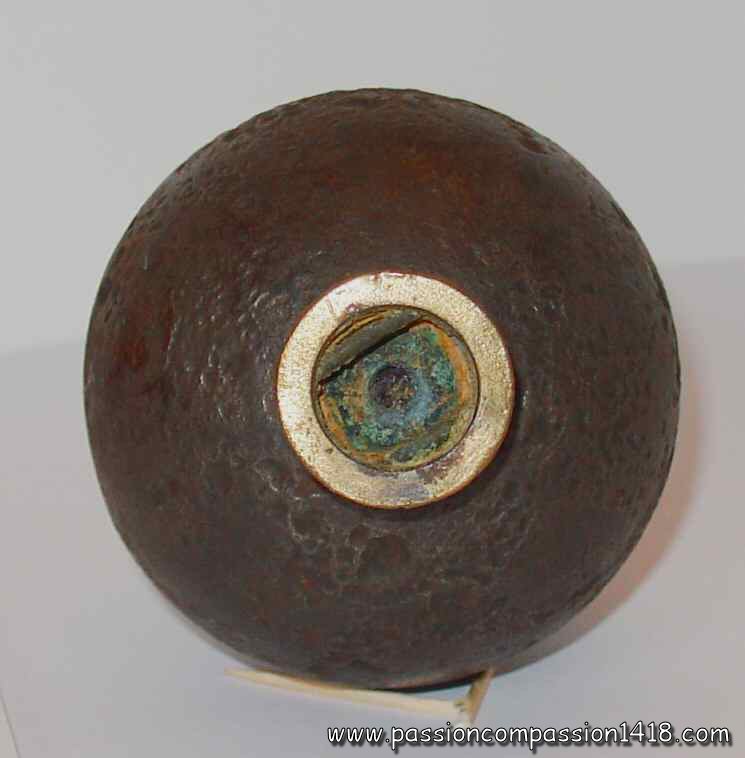 |
The grenade modèle 1914
is an improvement of the grenade modèle 1847 that was not only old, but was also suffering from several issues like its bad resistance to humidity and the non satisfactory fragmentation.
- The non waterproof issue was a problem noiced far before the war, but only the very wet life conditions in the 1914 trenches could convince that it was time to adopt the solutions that had been designed before. Therefore the wood fuze, that could be desagregated by water and was never acting as a seal for the sphere, was replaced by mold bronze fuze (fusée modèle 1914), with a wood plug drilled with a hole to access to the traction igniter kook, a delay of 4 seconds, and that could be screwed into the threaded hole of the new sphere.
- A solution to the fragmentation problems was given with pre-fragmentation grooves on the inner surface of the sphere (a weird solution : not easy to manufacture, not as efficient fragmentation properties and not giving better gripping properties to wet hands than the outer surface grooving solution...)
Pretty heavy, that grenade could be launched with the help of a wrist sling that was not convenient in the narrow spaces available in trenches. The optimism at the start of the war delayed the manufacturing of this new version so it was not dispatched to the French soldiers before 1915. At this time, more modern grenades types developped on the experience of the first fights were slowly arriving in the units. Meanwhile, the French soldiers had to fight with the old grenades model 1847 or 'do-it-yourself' solutions such as the hairbrush grenades !
Weight 1 kg, including 110 g black powder (later replaced by cheddite)
|
Model 1914 grenade, with 1914 fuze without its wood plug |
Model 1914 grenade, upper view. One can see the hole where the traction igniter wire was passing through |
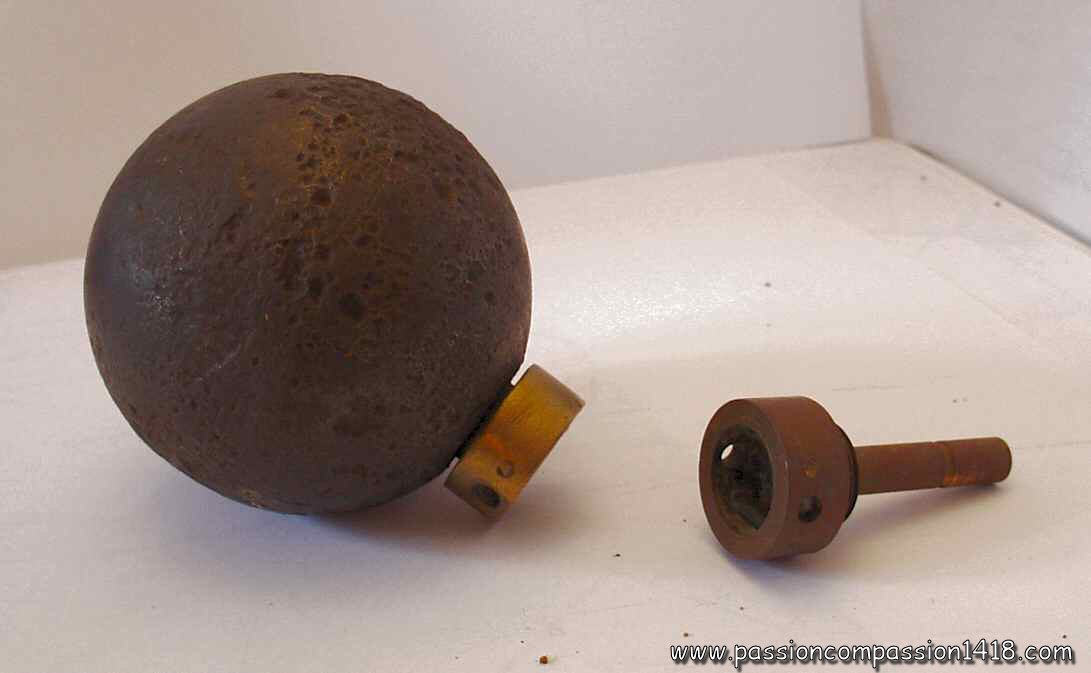 |
Model 1914 grenade. Detail of an igniter model 1914 observed in Verdun - Cote du Poivre |
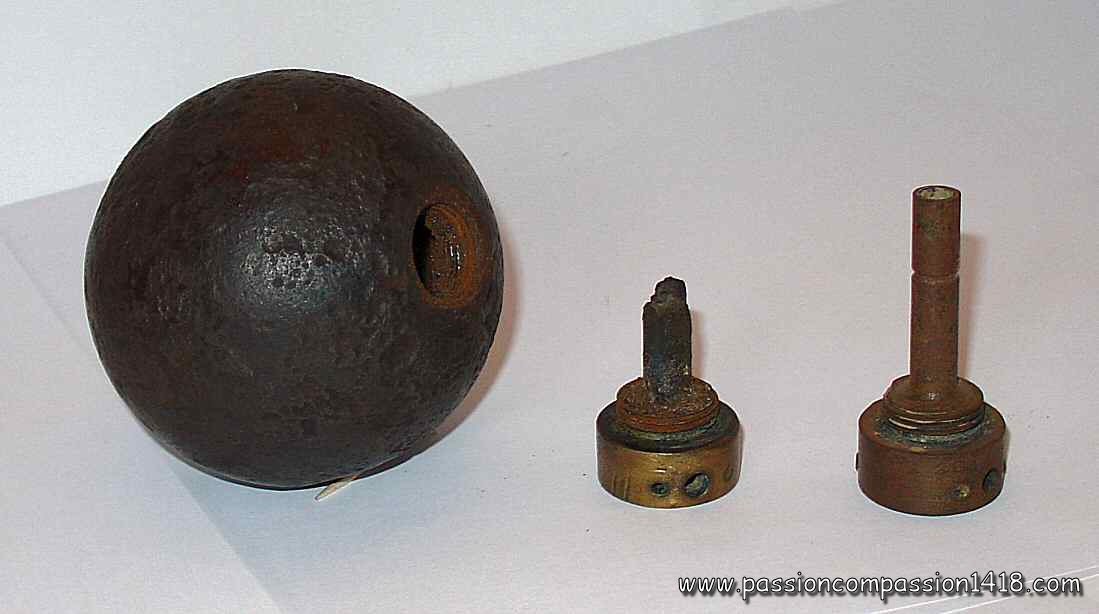 |
Model 1914 grenade, dismounted with 2 separated igniters. See the thread in in the grenade hole |
|
|
Return at the top of page |
Grenade Besozzi
|
 |
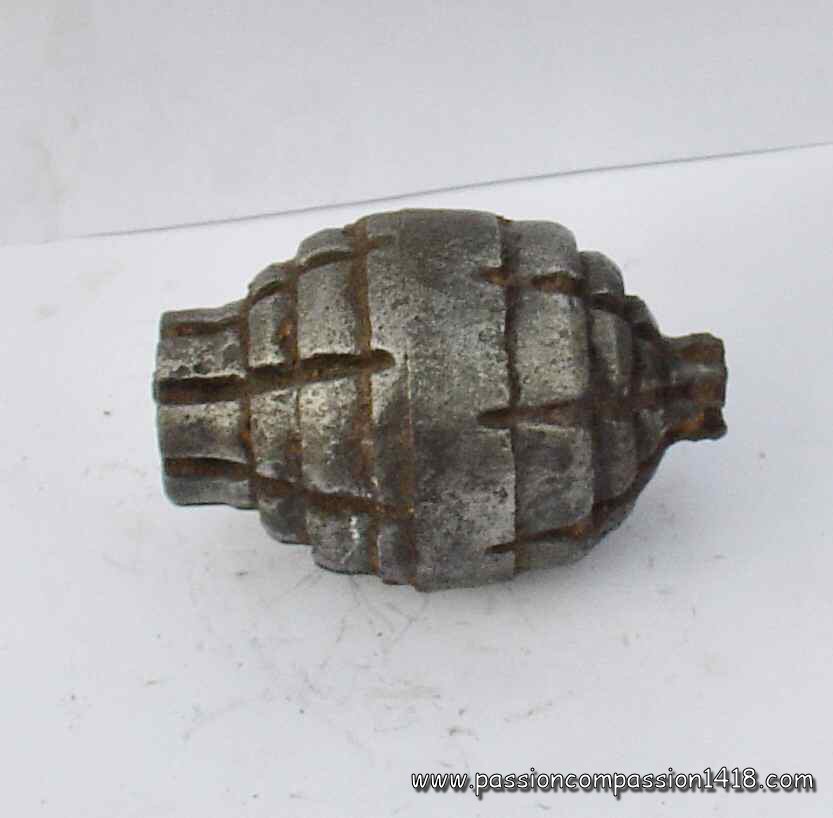 |
Whatever or whoever the origin, the early 1915 idea to import from Italy, then in peace, grenades available in good quantities was a brilliant idea. The grenade Besozzi allowed to supply the French soldiers with a relatively modern hand grenade, without requiring an additional effort to a already overloaded French war industry.
Whe Italy joined the war with the Allies in 1915, the production was transferred to French manufacturers under licence so that the Italian plants could dedicate fully to their own armies.
This grenade must be considered as a step on the road to the developement of modern grenades. In one hand, its shape, the external fragmentation and in handiness was giving a good taste of the new weapons that would be soon available, its igniting system, using a wick with a phosphorated head, that had to be rubbed onto a supplied scrubbing brush, but more successfully ignited with the furnace of a pipe, was rather 'primitive'.
Realized by mounting of two pig iron moulded hemispheres, Réalisée par montage de deux calottes en fonte, it seems that the models made in France had a side throat for the exit of the wick, while the wick exited perpendicular to the surface for the models imported from Italy. Once assembled, the grenades were dipped into paraffine for waterproofing.
Weight 630 gr. including 60 gr. 'P' explosive.
|
Besozzi grenade observed in Champagne |
Besozzi grenade observed in Champagne - typical shape with a large base compared to the narrow head |
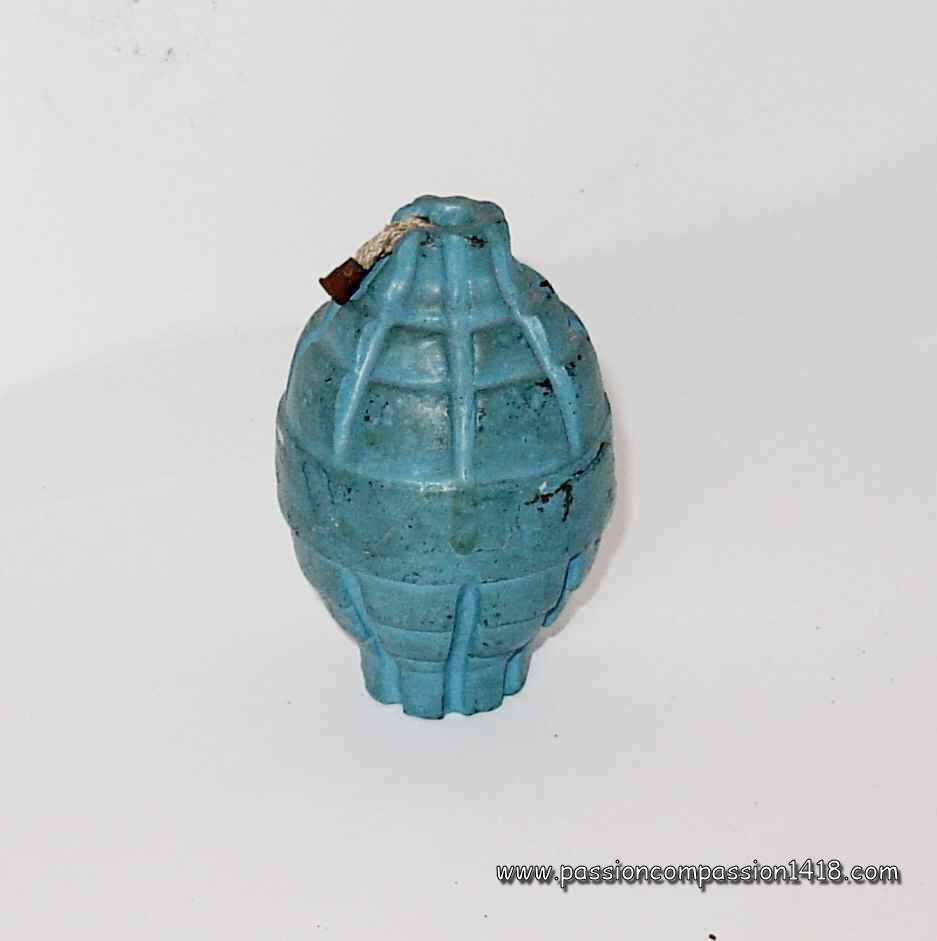 |
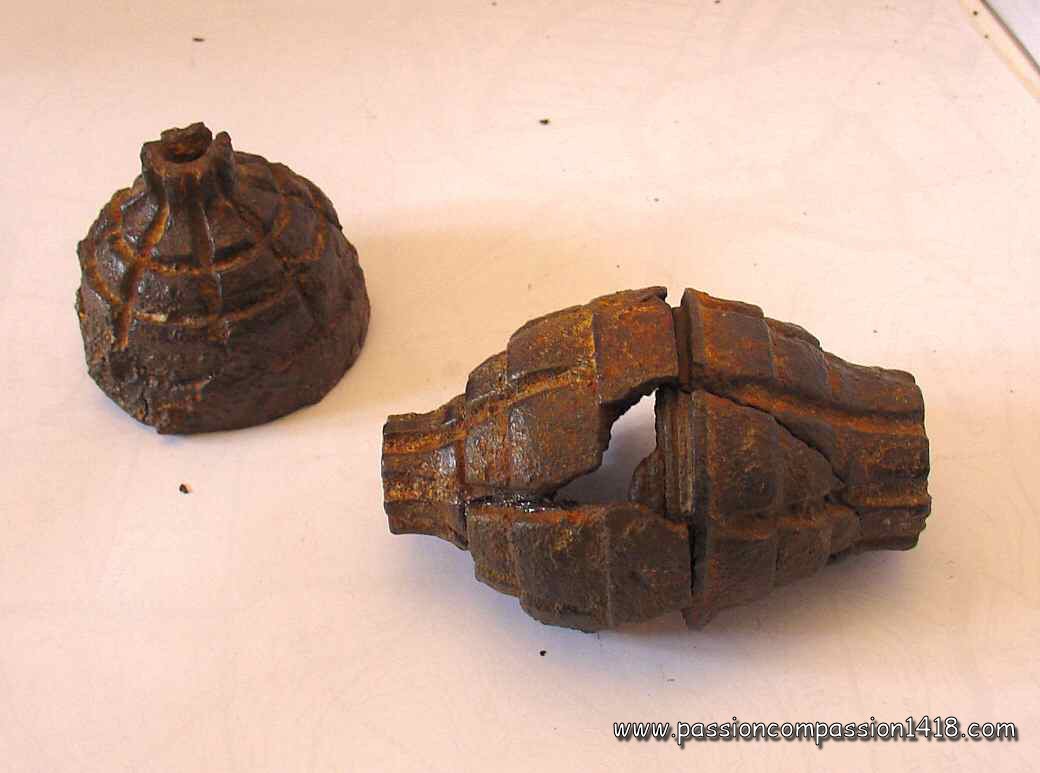 |
Besozzi grenade observed at La Targette Museum - Color and igniting string are not the original ones, but they give a good idea of the real thing. |
This tentative of a rebuilding of a Besozzi grenade from fragments found on the battlefield shows the fragmentation was not always very succesful. |
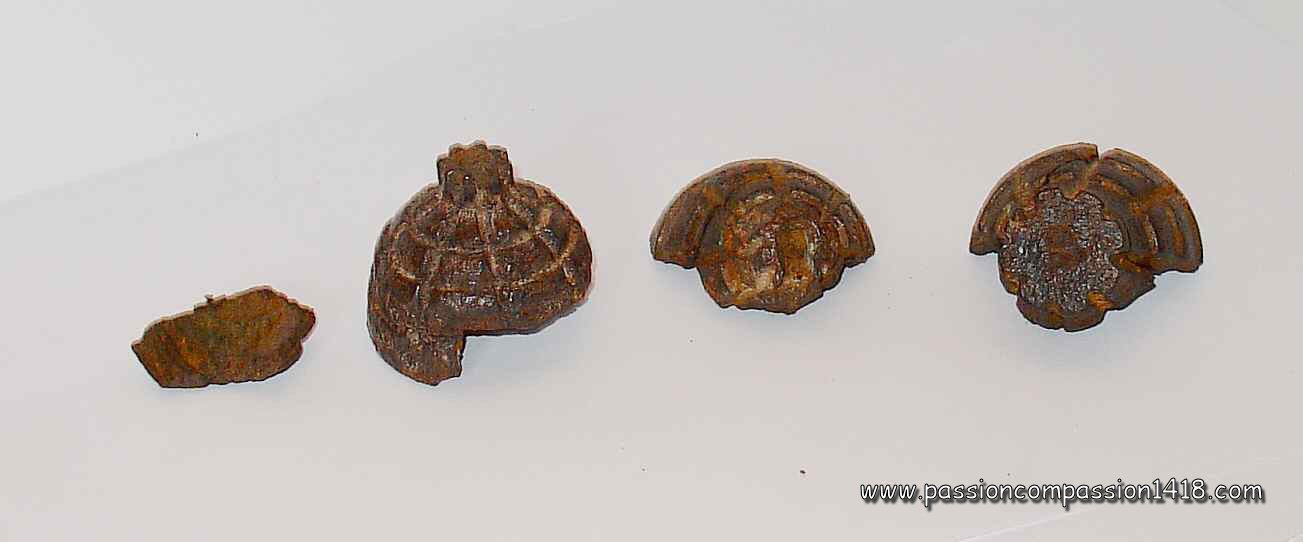 |
Fragments of Besozzi grenade found in Champagne - Main de Massiges |
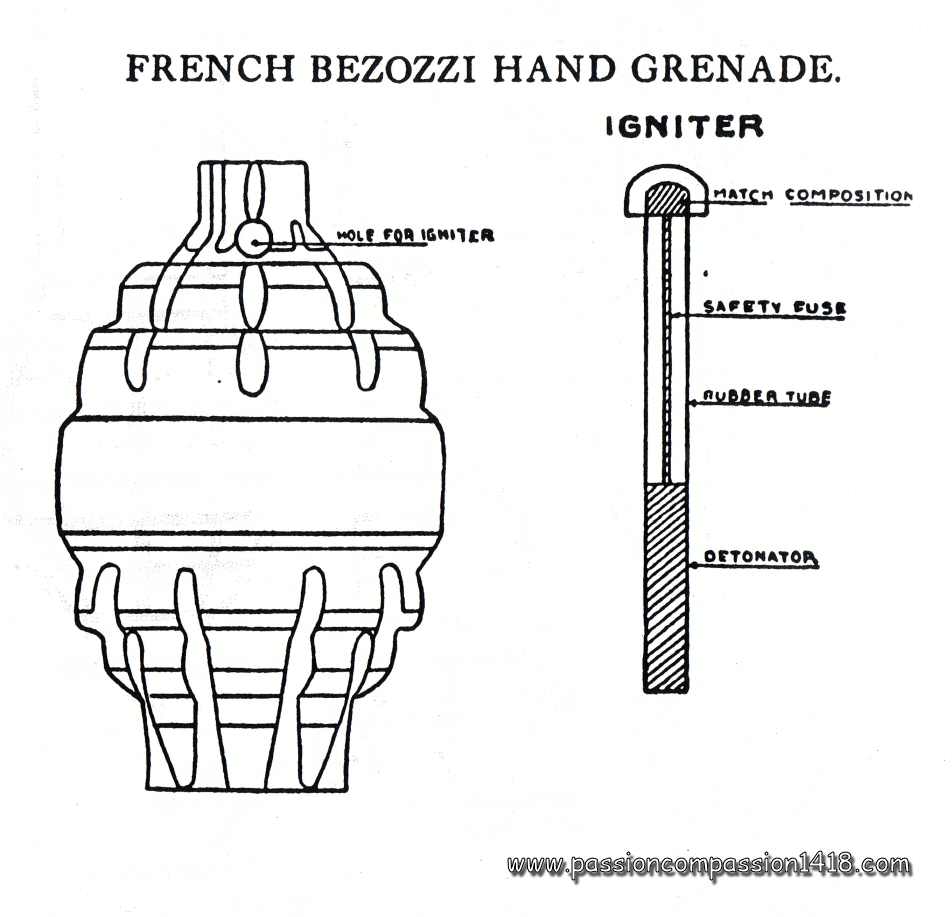 |
|
Besozzi grenade - wartime scheme. |
|
|
|
Return at the top of page |
Grenade P1
Grenade Percutante nr1 - 'Pear' or 'Spoon'
|
 |
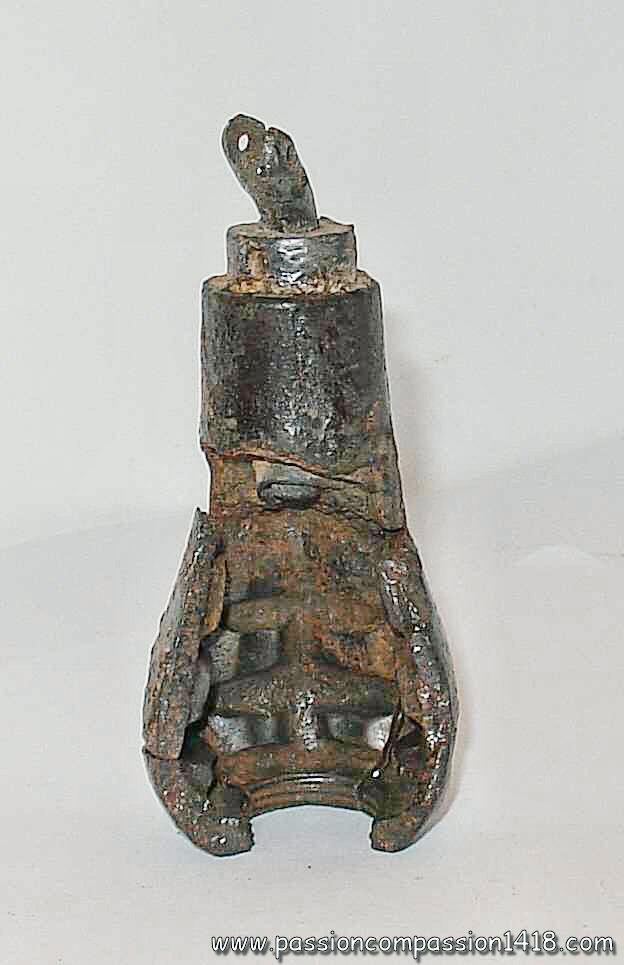 |
As soon as the 17th century, a major issue of the fuse grenades appeared to the fighters : as long as the wick is not totally consumed, it is always possible to send back the grenade to the expeditor ! The idea of a percussion grenade is therefore pretty old, but its design met a lot of complex problems that were far from being perfectly solved in 1914 in any of the fighting armies.
At the beginning of the war, the French Army used artisanal percussion 'bangers', as well as Aasen grenades (from the name of that Danish inventor who was selling the same grenades to the Germans...), but none of these weapons gave entire satisfaction. But in May 1915, the French soldiers finally receive a brand new grenade P1 (percutante n°1) percussion grenade designed and made in France by Mr Billant (who also invented automatic lever grenade igniters of the same name).
This new weapon was almost immediatly nicknamed 'Pear grenade' or 'Spoon grenade' by the fighters, because of evident reasons understandable with just a look on the pictures. The grenade was made of a pig iron body with inner fragmentation grooves, closed at its base by a lead plug, and on the top by the igniter mechanism. This mechanism was composed by a detonator triggered by a starter that was hit by a moving percussion pin when the grenade landed vertically on its base. This percussion movement was only possible when the spoon-like lever was up. A security wire wrapping the spoon lever and the grenade body at rest had to be cut prior to launching the grenade, so that the rotation of the lever was possible.
Unwanted arming of the grenades by rupture of this wire and movement of the aluminium or steel spoon lever caused numerous accidents. Moreover, the absolute need for the percussion system to have the grenade landing vertically on its base not only induced the pear shape of the weapon but was also supposed to be helped by a tissue band wrapped under the spoon and acting like a tail in flight. Despite these two precautions, the results were rather uncertain...
Dangerous, unreliable ignition system, often unsactisfactory fragmentation (see the pictures), this grenade, however extensively produced and used, was far from being a success !
Weight 550 gr. including 30 gr. 'P' explosive.
|
'Spoon' grenade - the aluminium side lever, blocked with the security wire, is really looking like a table spoon. |
Fragmented spoon grenade - Observe the internal pre-fragmentation pattern |
 |
Spoon grenades re-built from their fragments, proof of the highly perfectible fragmentation properties ! (Observed in Verdun - Hill 304, and Chemin des Dames) |
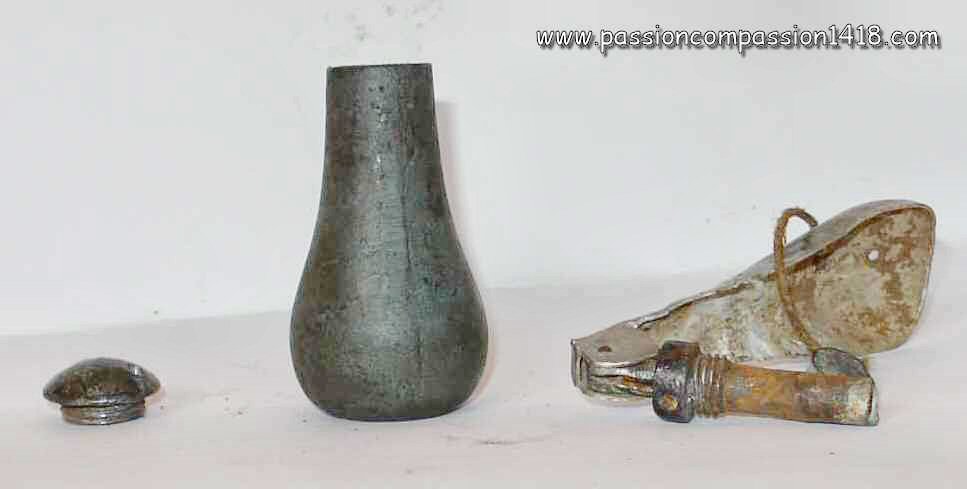 |
'Pear' grenade - the specific shape designed to make the base heavier and induce vertical landings is justifying that other 'pear grenade' nickname. Dismounted igniter and bottom plug. |
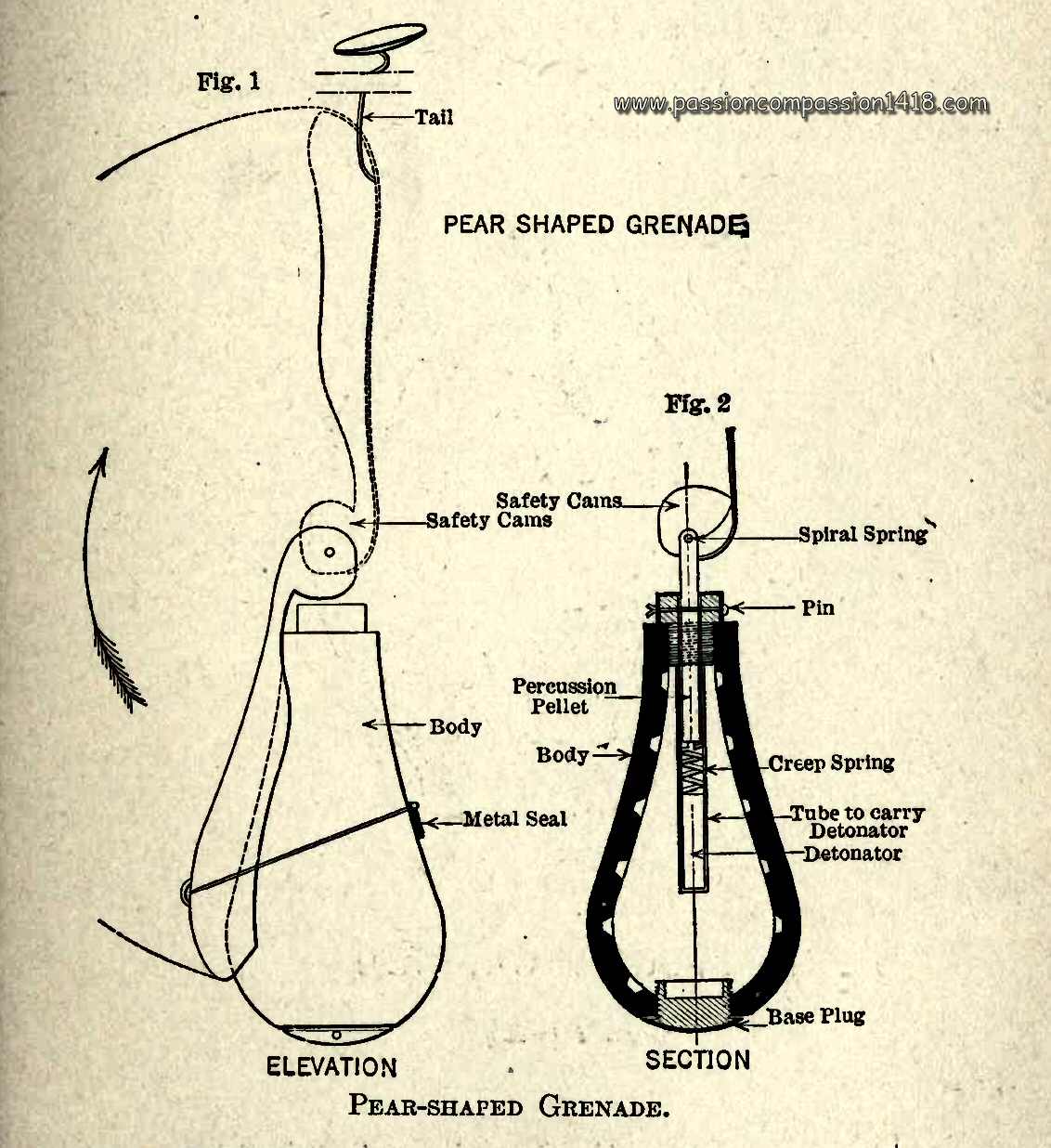 |
|
'Pear' grenade P1 - wartime scheme. |
|
|
|
Return at the top of page |
Grenade F1
Grenade Fusante nr1
|
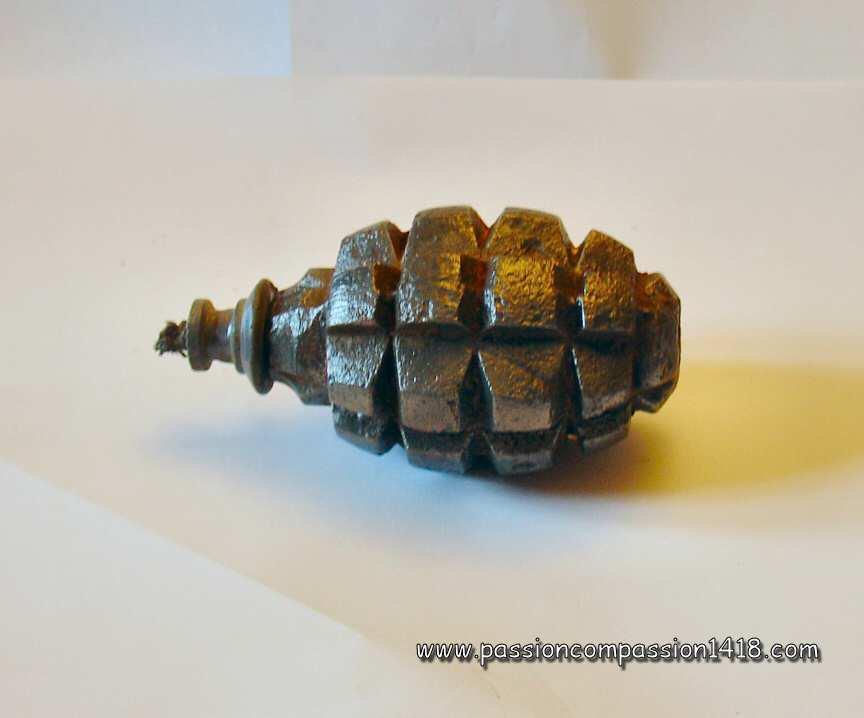 |
 |
In May 1915 the very first grenades F1 (fusante n°1) appeared in restricted quantities. This new weapon inherits from the experience of the first months of the war : the shape is more modern yet, with an external grooves pattern for a better handiness and an easier fragmentaion. This latter expectation was a deception, since the explosion usually gave no more than 10 fragments (although the pattern was counting 38 divisions) dangerous in a 200m radius.
This grenade body will follow the technological evolution of the French ignitersLe corps de cette grenade va accompagner l'évolution technologique des allumeurs Francais. During WW1, it was successively mounted with a :
- wick ignition plug {not confirmed by the litterature, but many examples using that early technique have been observed on former 1915 battlefields)
- model 1915 percussion ignition plug, made with a 5 seconds wick inside a lead tube logée dans un tube en plomb, connected at one end to a detonator, and at the other end to a 9mm diameter cardboard tube with a percussion pin at its top. This system was covered by a sliding 12mm diameter cardboard whose inner bottom was equipped with a starter. The whole assembly was finally protected ba a last cardboard tube that was indeed a hunting ammunition cartridge. The grenade ignition was triggered by removing the protection tube, then hittng the head of the percussion tube, propulsing the starter to the percussion pin, that would ignite the 5 seconds wick
- model 1916 percussion ignition plug, having a similar principle than the previous one, however trying to solve its major issues : a too big height of the percussion system, that induced the need of a very precisely vertical percussion , and its sensibility to humidity. Therefore, the carboard elements were replaced by shorter brass tubes. Even after this upgrade, the good use of the igniter was still conditionned by a rather precise control of the percussion force, hardly obtainable by a soldier under fighting stress.
- model 1916 B Billant automatic ignition plug. This modern igniter, externally pretty similar to the famous 'Mills' grenades igniter, was triggered by removing the safety pin that forbid the lever movements, then launching the grenade. As soon as the latter left the launcher palm, the lever rotated upside under a spring action and triggered the firing of two starters hit by the branches of a spring, igniting the 5 seconds wick.
From the beginning of 1916, and equipped with this latter ignition plug (quite rare since it needed fine steel thin plates for its making), this grenade became the most common used one by the French soldier for the rest of the war. It was continuously used until 1940.
Weight 630 gr., including 60 gr. cheddite
|
Grenade F1 avec un allumeur à mèche du type ancien. Pas de trace du vraisemblable couvercle de protection. |
Bouchon allumeur à mèche, plus trapu que les modèles suivants |
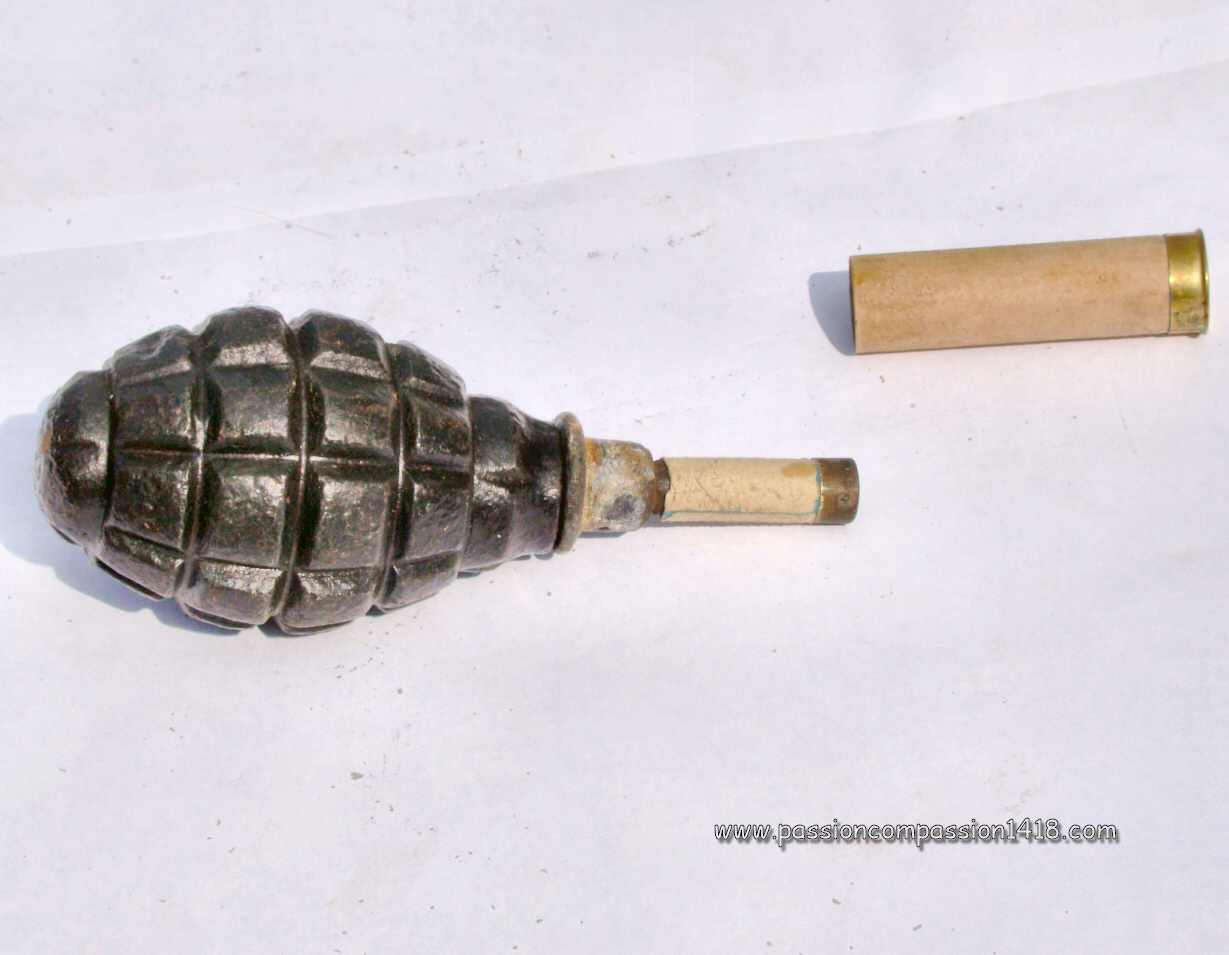 |
 |
Grenade F1, équipée du bouchon allumeur à percussion modèle 1915. Coiffe de protection retirée |
Grenade F1, bouchon allumeur à percussion modèle 1915 démonté. Remarquer le rugueux en tête du bouchon et la longueur de la colonne qui le porte. |
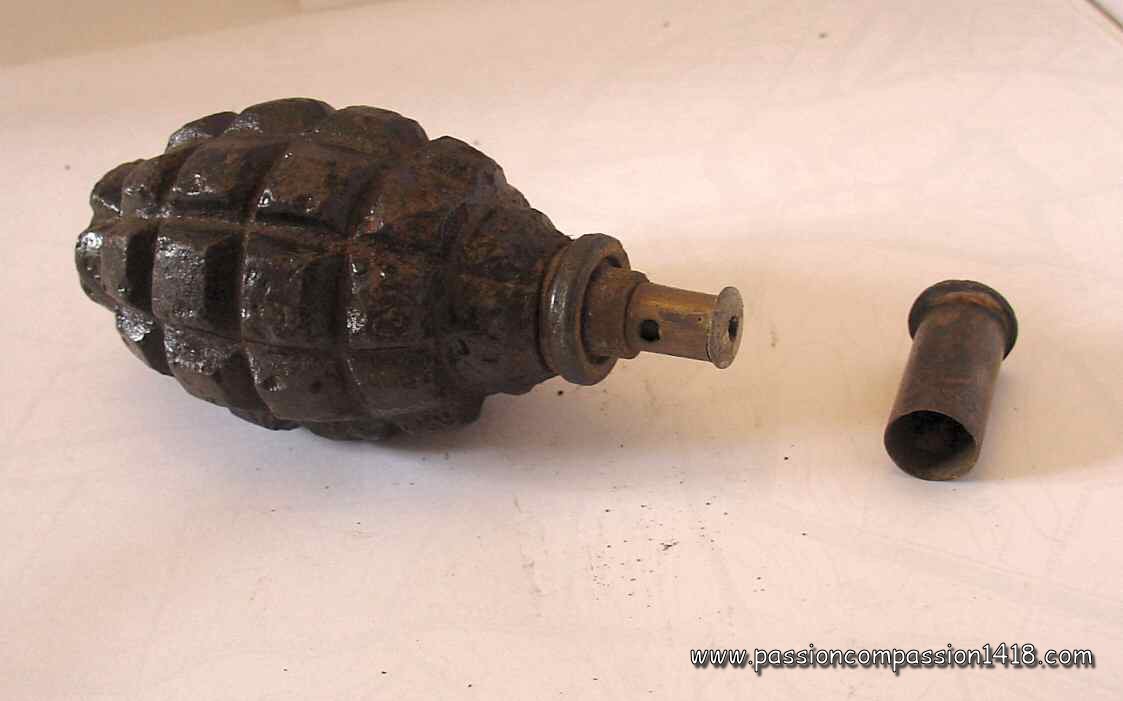 |
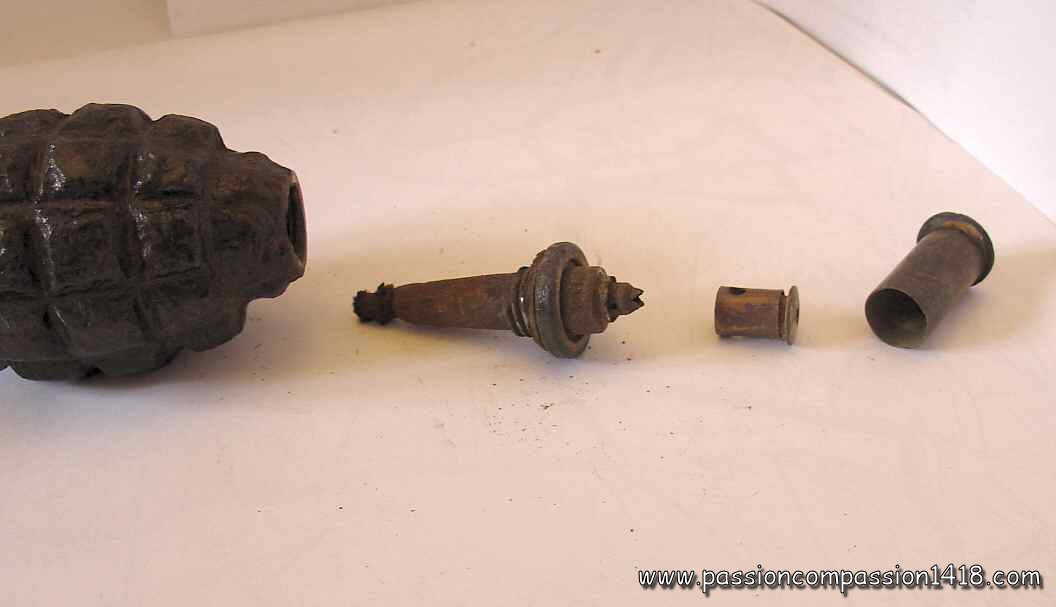 |
F1 grenade, removed protection cap |
F1 grenade, détail of the friction igniter |
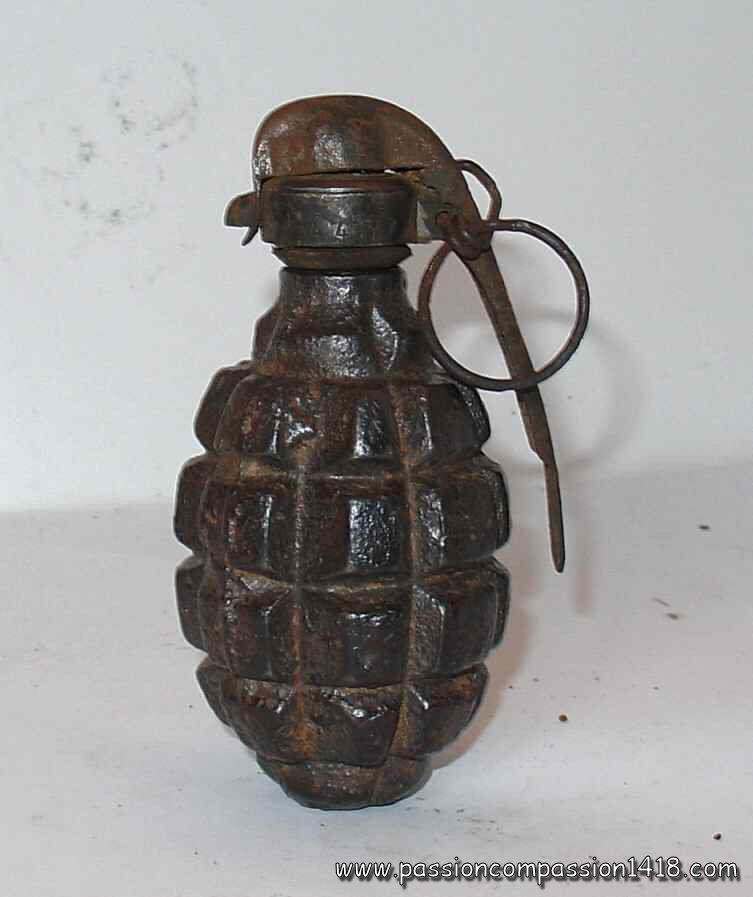 |
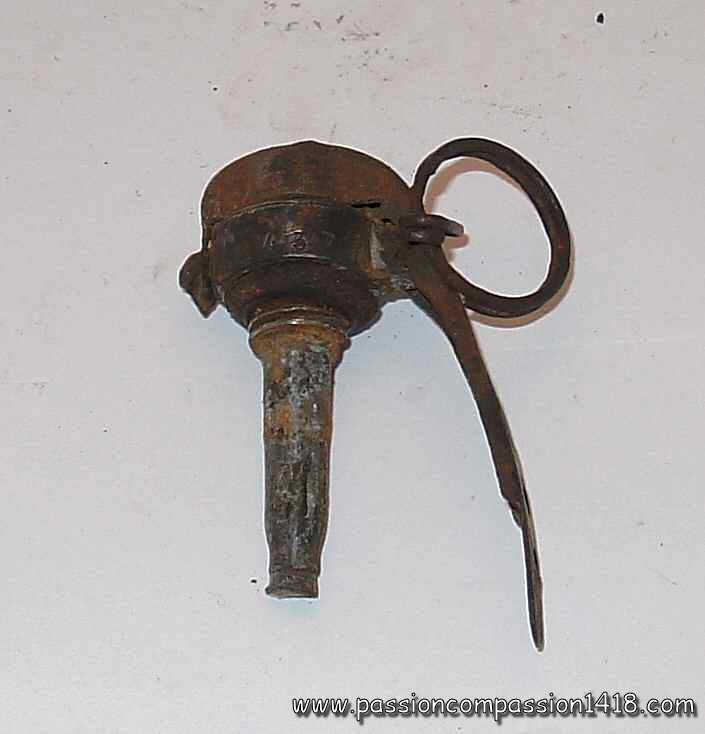 |
F1 Grenade with new automatic igniter Billant modèle 1916 B (mills type) |
Detail of the automatic igniter Billant modèle 1916 B |
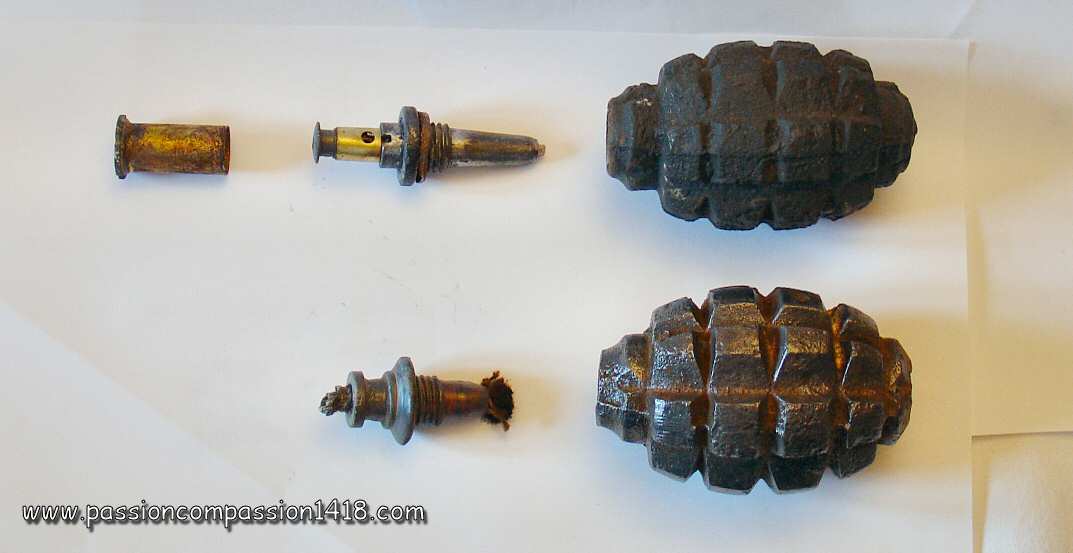 |
Dismantled friction igniters, to compare the sizes of the newer (on top) and older one (bottom). |
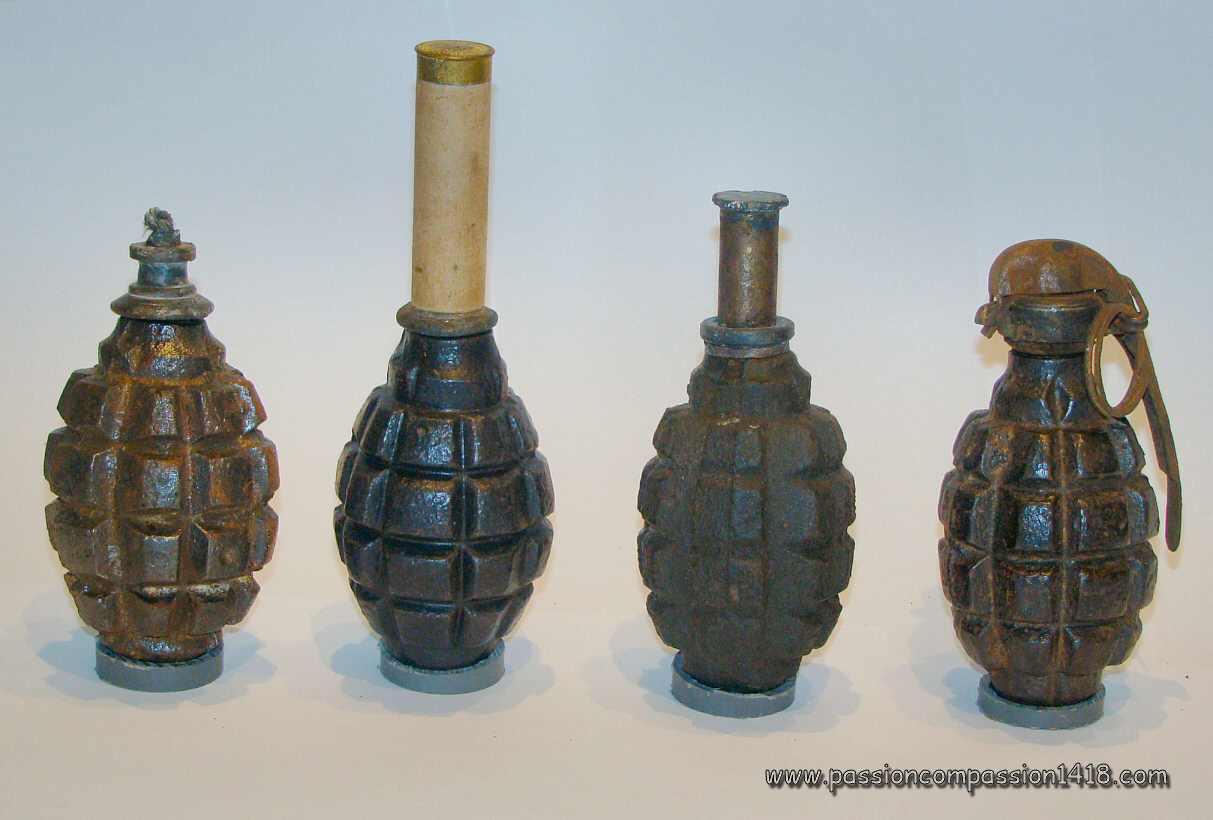 |
Collection of F1 grenades, with different igniters |
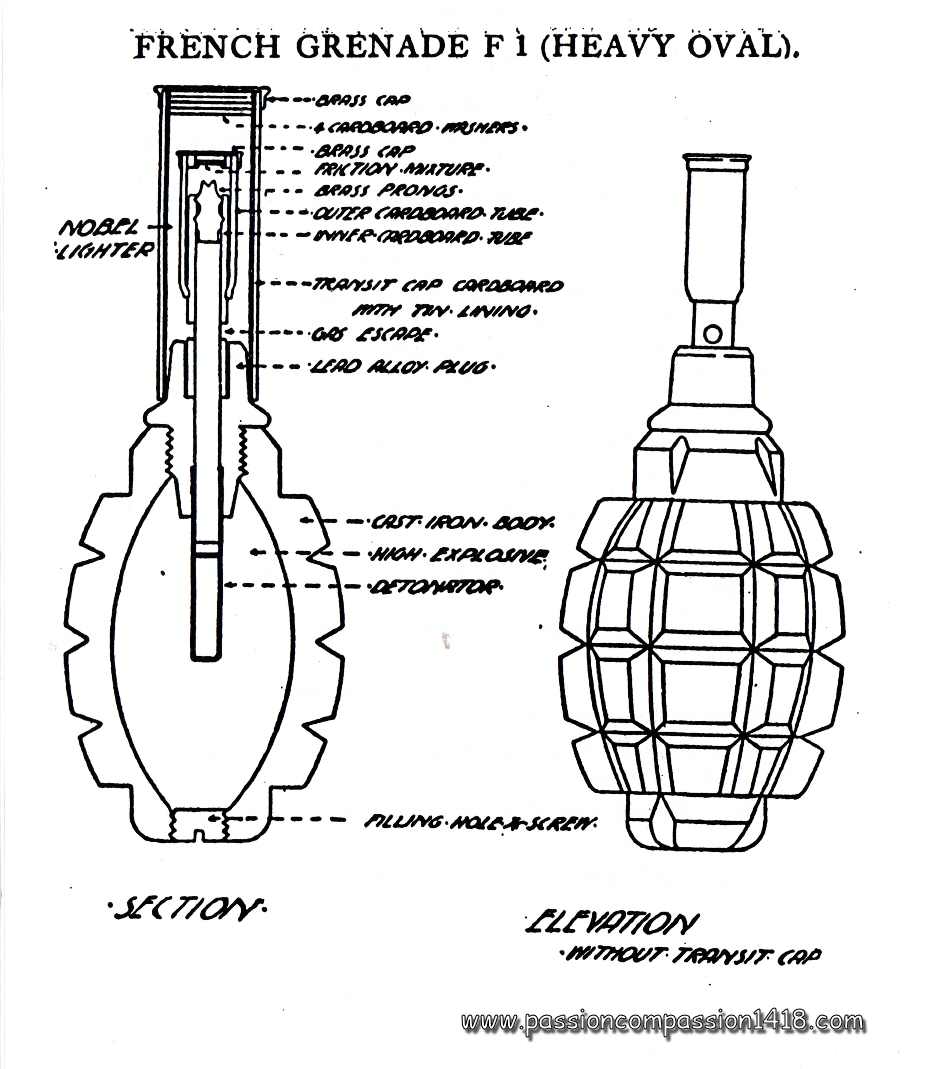 |
|
Grenade F1, wartime scheme |
|
|
|
Return at the top of page |
Ball grenade model 1914
Model 1914 grenade
|
 |
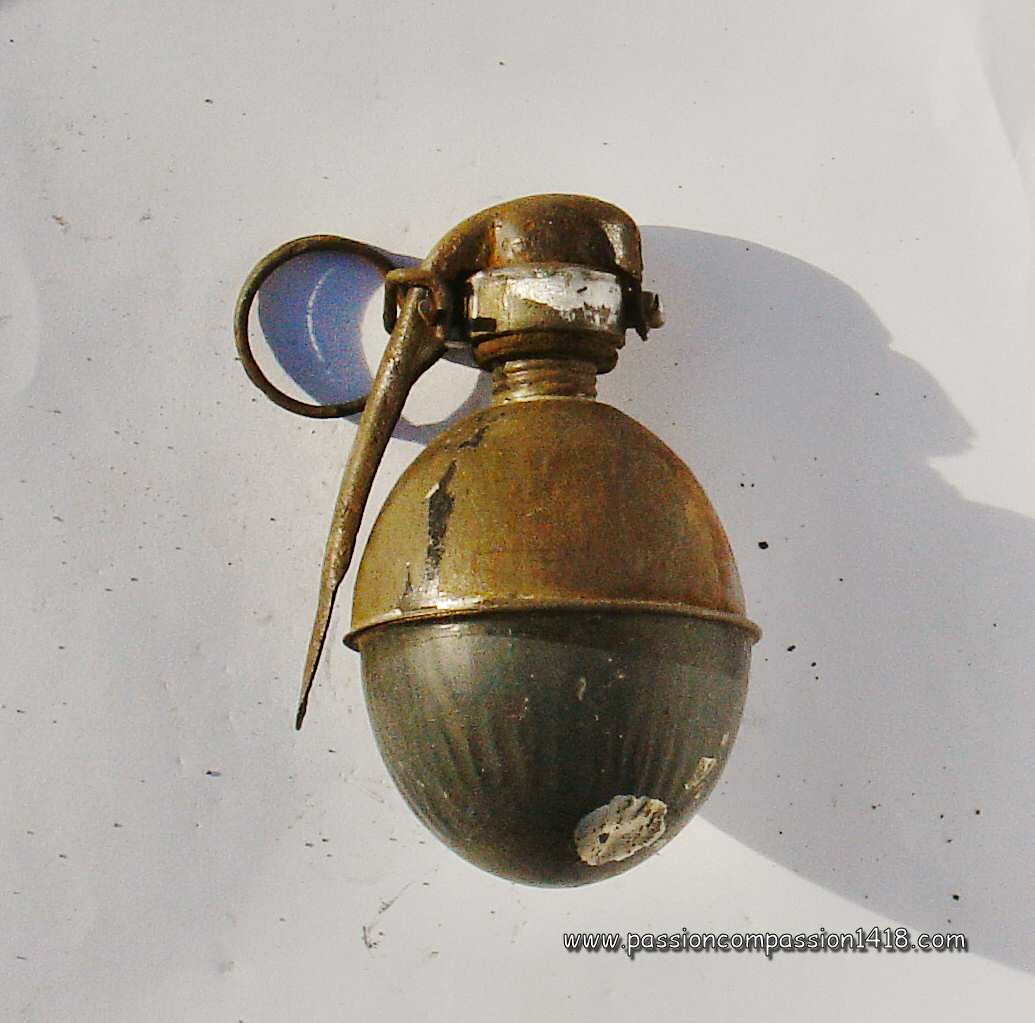 |
The experience of close combat and assaults in the confined space of WW1 trenches prooved that the large dangerosity range of the classical grenades was about equally endangering the launcher and the target. Since the goal was mainly to knock out or frighten the defenders, the concept of the offensive grenade was proposed, in opposition to the other type, named defensive grenades.
The grenade OF1 (offensive n°1) that appears in 1915 corresponds to that specification, with a reduced action range. It is composed of two stamped iron hemispheres crimped together and tin welded. The igniting plug was screwed inside the upper hemisphere, whose complex forming needed that part to
be stamped in a higher quality thin plate, while the lower cap could be made in a more common grade thin plate.
This grenade will follow the same igniting plugs technological evolution as the F1 one, the latest WW1 evolution giving it the famous Billant Modèle 1916 B plug. The explosive charge also progressed all along the war, from the initial cheddite to the Schneiderite, and finally the NTMX, allowing each time to reduce the total weight.
Weight 250 g including 150 g cheddite, then 120 g Schneideirite and finally 105 g NTMX.
|
OF1 grenade, wartime scheme of the body |
OF1 grenade, equipped with a Billant igniter |
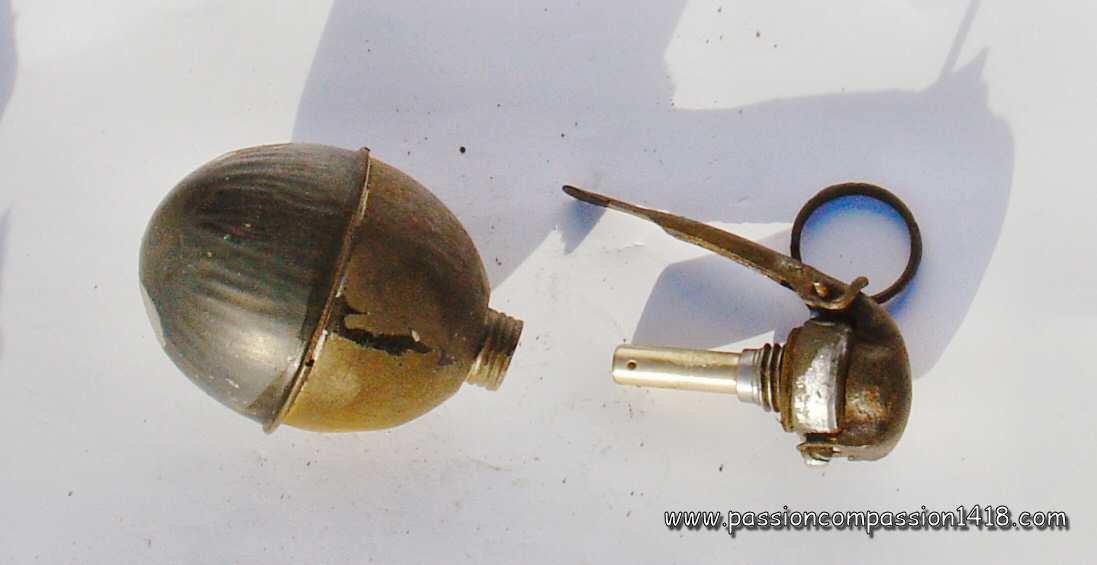 |
OF1 Grenade with dismantled new automatic igniter Billant modèle 1916 B (mills type) |
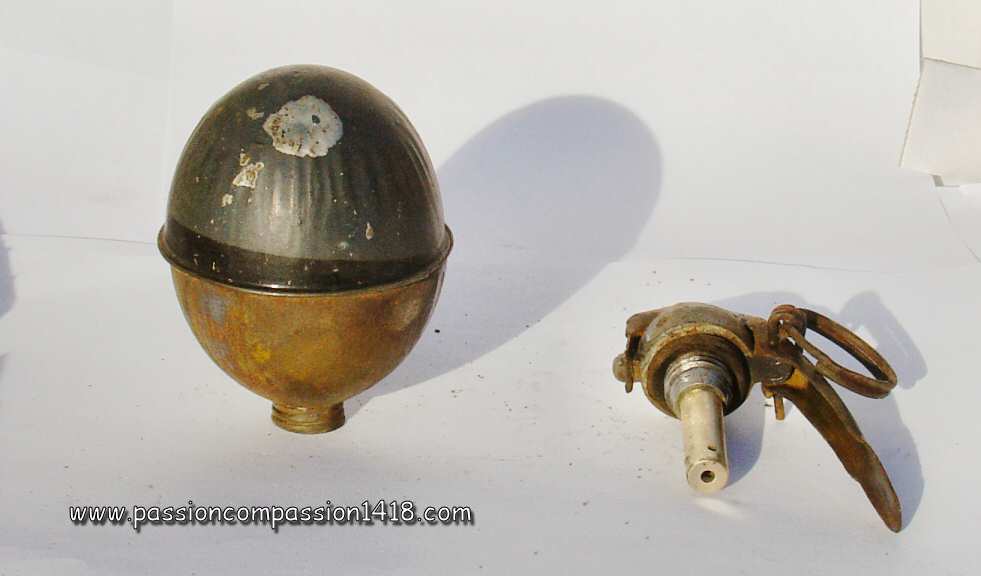 |
Bottom view of the automatic igniter Billant modèle 1916 B. Note the usual stamping defects on the lower hemisphere, made in a lower quality iron plate. |
|
|
Return at the top of page |
Grenade 'lemon' Foug
Grenade Foug 'Citron' modèle 1916
|
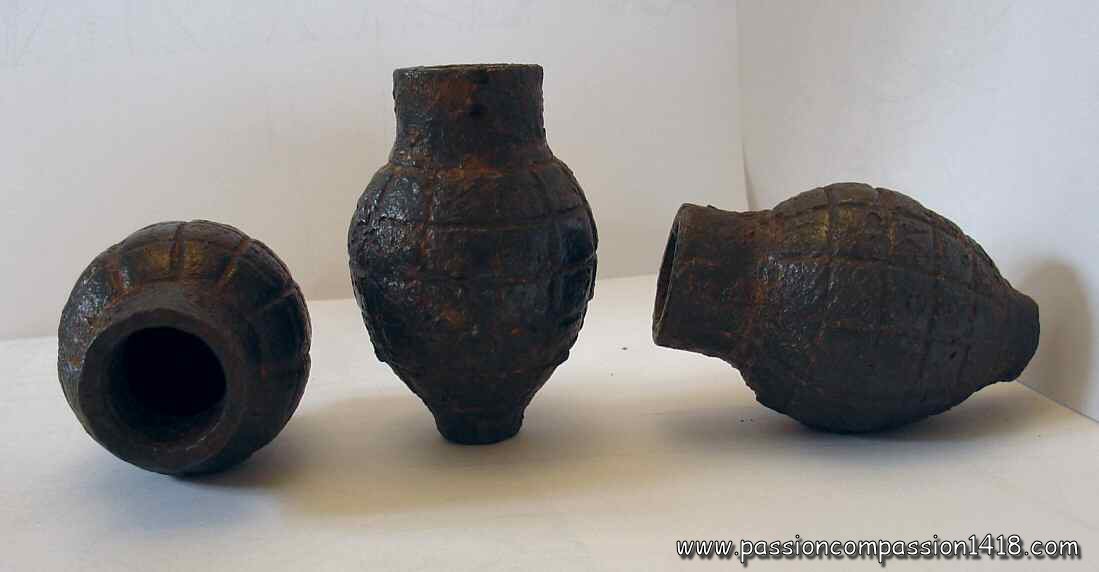 |
As soon as April 1915, the military manufacture of Foug, in Meurthe et Moselle near Toul, began to produce simple grenades models, including a copy of the famous German stick grenade, and two 'asparagus' grenades (a long then a shorter) in prefragmebted steel equipped with a rudimentary wooden igniting percussion plug.
The grenade Citron Foug modèle 1916 is a evolution of this 'asparagus' grenade, mainly designed to reduce the weight and improve the fragmentation properties. This latter point conditionned precisely the profile of the body, whose influence had been found to be higher on the fragmentation then the shape of the grooves themselves.
The igniting system was rudimentary, made of a percussion block moving inside a wooden plug equipped with a starter, and linked to a detonator. With no other safety device than a simple spring, it was quite dangerous despite the addition of a removable safety cap in thin iron plate (with flat, then conical, then hemispheric top) covering the ignition plug during transportation.
Its 'citron' ('lemon') nickname was obviously given by its very recognizabe profile. Despite its rudimentary design and its relative dangerosity, its lean manufacturing cost and process allowed this grenade to be made by a lot of manufacturers and available in big quantities, and therefore massively used from 1916 until the end of the war.
A complete description must include the use of this grenade, mounted on a wooden block, by a small trench launcher named 'fusil Guidetti de 65mm'.
Weight 550 gr., including 90 gr. of cheddite.
|
3 empty 'lemon' grenades (observed in Verdun - Côte du Poivre) |
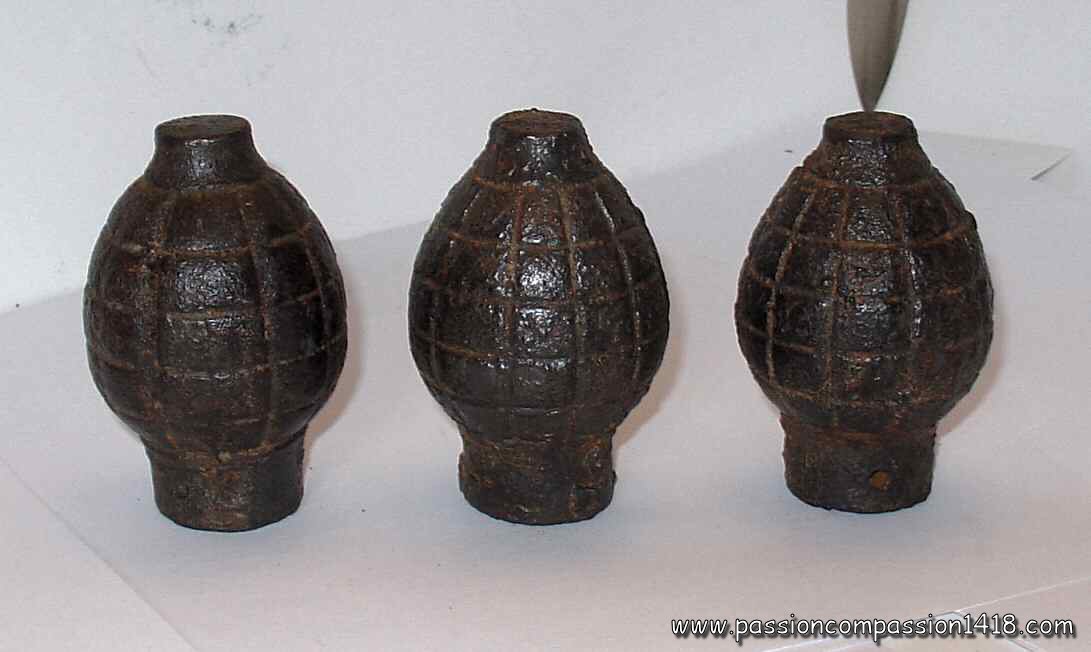 |
The same grenades - note the difference of the square pattern, demonstrating that the machining specifications sent to the numerous manufacturers were quite permissive. |
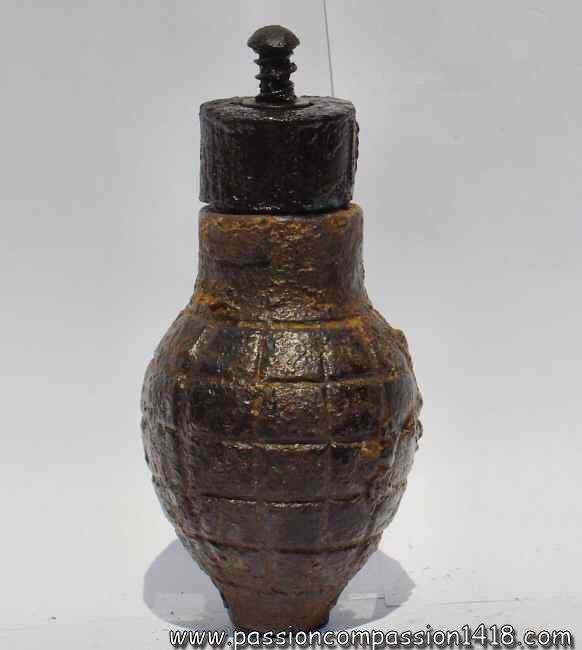 |
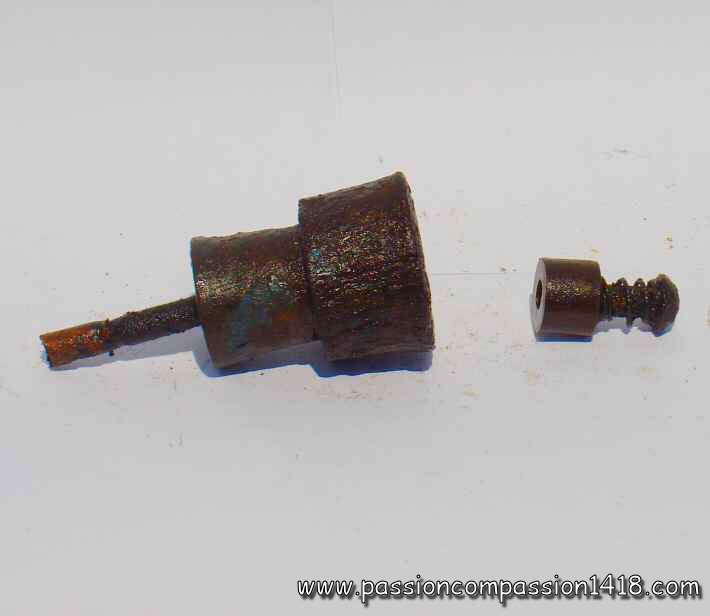 |
Foug 'lemon' grenade equipped with its wooden percussion plug igniter (observed in Champagne) |
Detail of the dismounted wooden percussion plug igniter |
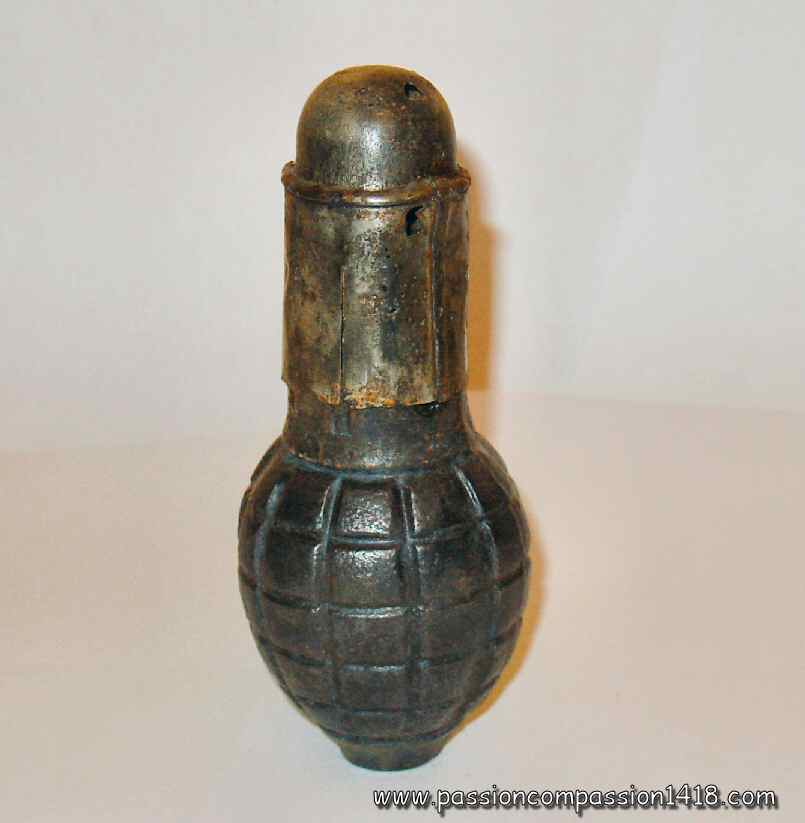 |
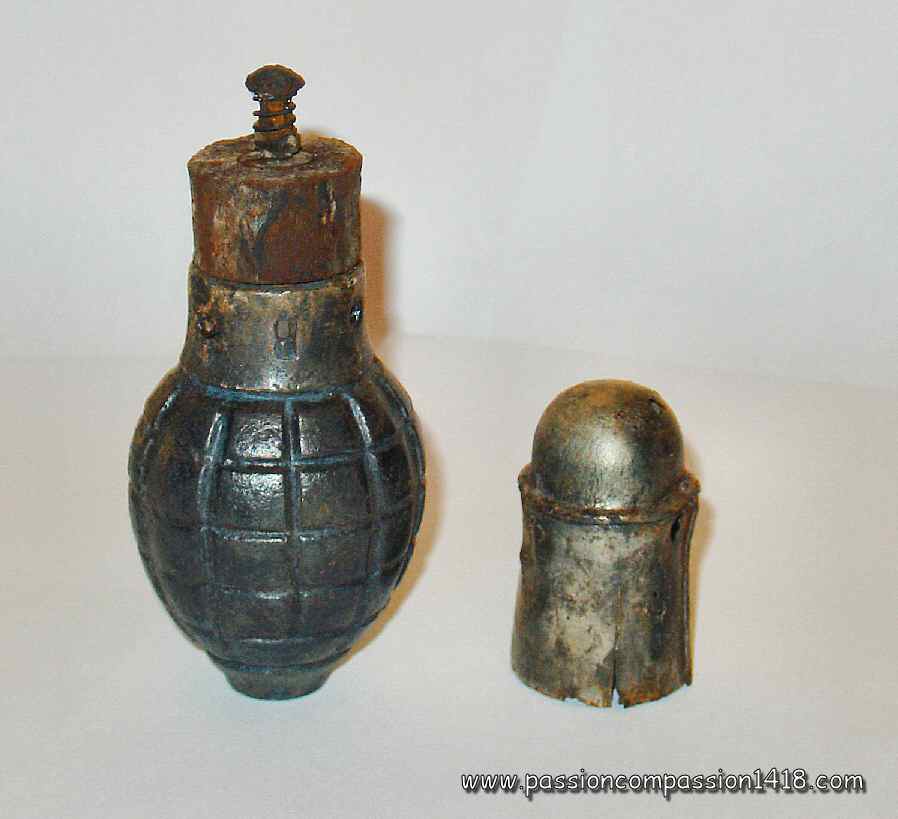 |
Foug 'lemon' grenade covered by the thin metal protection cap (observed in Champagne) |
Foug 'lemon' grenade, protection cap removed, 'ready for use' |
 |
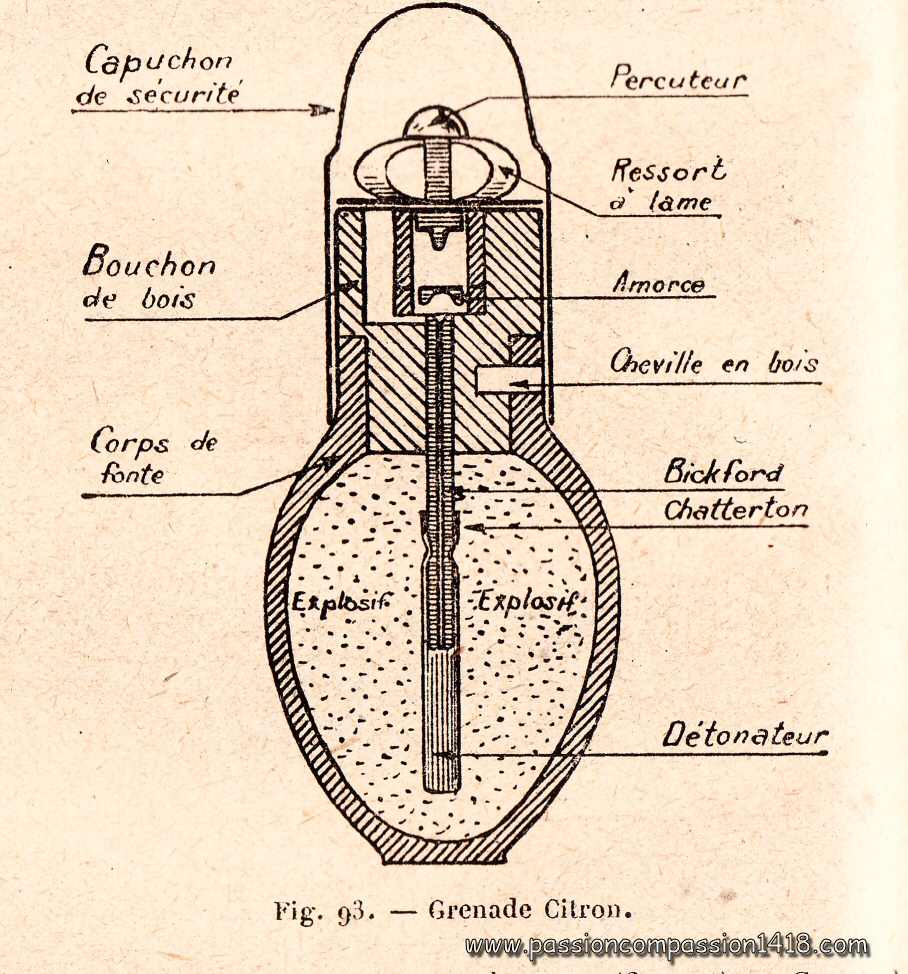 |
|
Foug 'lemon' grenade - wartime scheme |
Foug 'lemon' grenade - wartime scheme - later model |
|
|
Return at the top of page |
Feuillette grenade
|
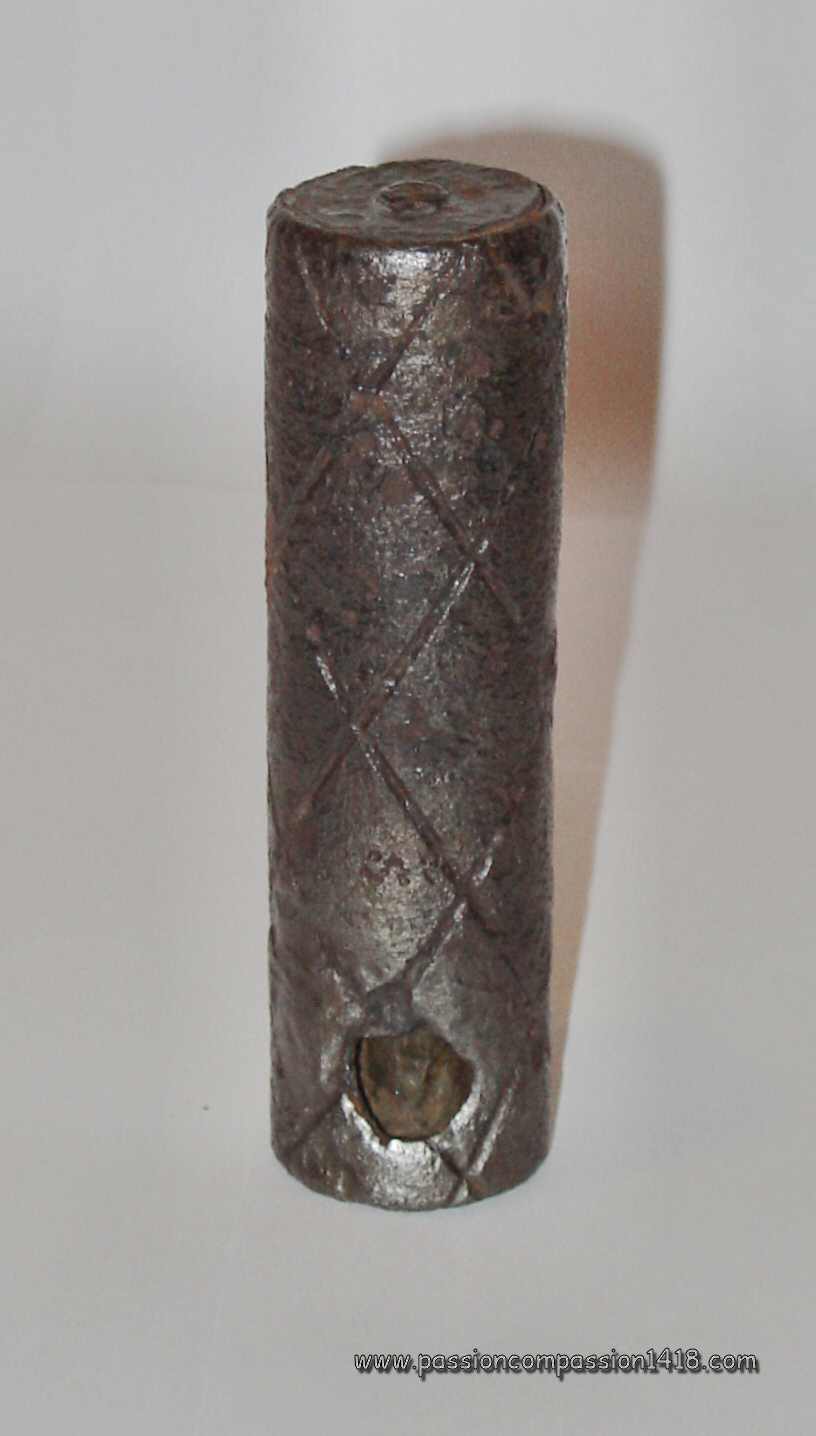 |
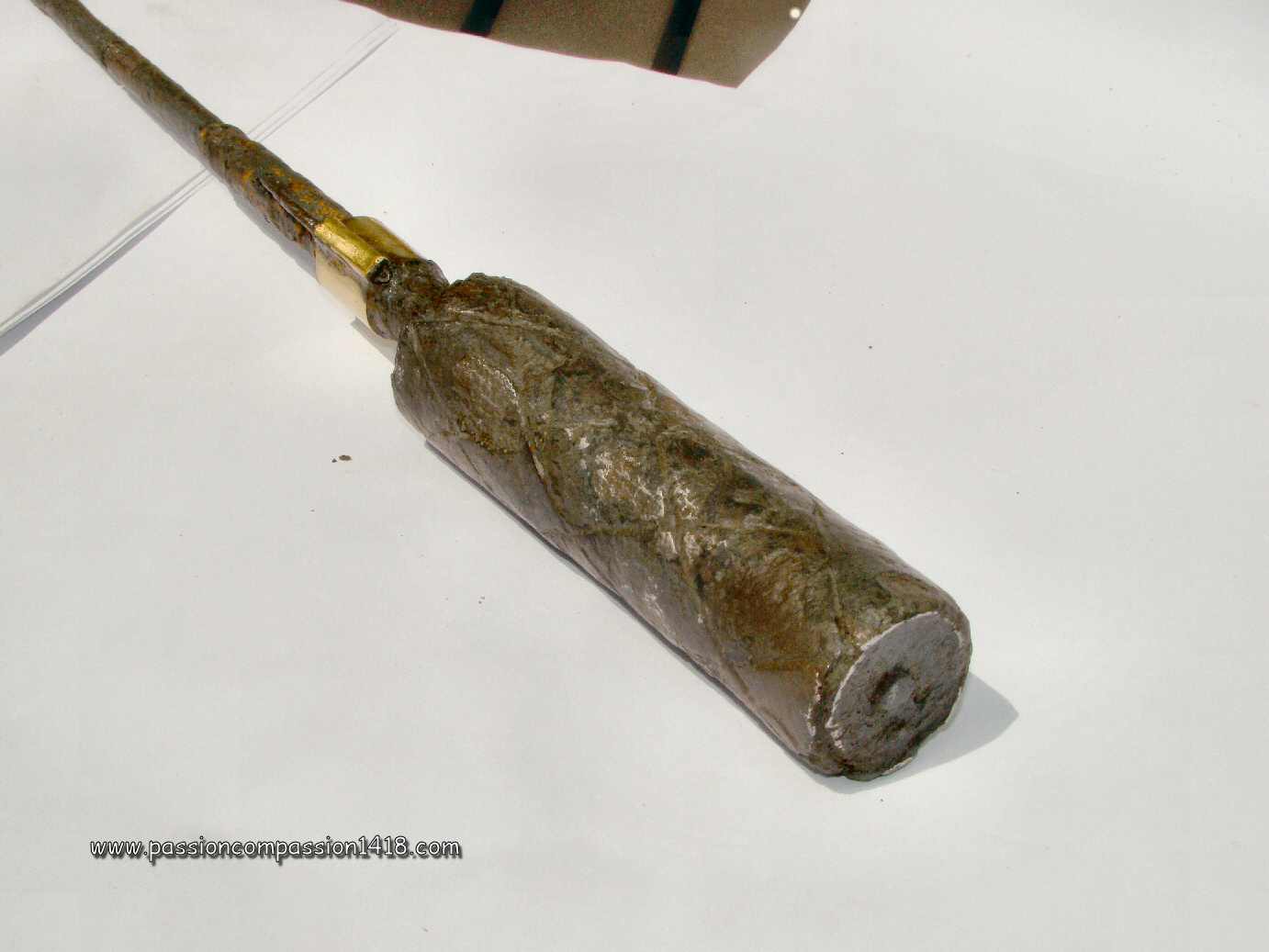 |
At the beginning of the war, the French Armies arsenal was not including any rifle grenade, although interesting in many tactical situations where short range immediate extra firepower is needed. For that reason, France first equipped with Martin-Hale Nr2 British grenades, awaiting for the development of a French design. This latter, the grenade Feuillette, is a weapon comparable to the English and German ones already in service.
It was made out of a steel prefragmented tube, with an axial detonator triggered at impact by an percussion pin fixed on an inertia block inside the triggering system screwed at the base of the projectile. This inertia block movements were blocked by a ring that was kept in place under the action of a safety hook. Finally, a steel rod was screwed behind the triggering system, to be inserted inside the barrel of the Lebel infantry gun.
The firing procedure needed the soldier to insert a blank cartridge in the Lebel gun breech, insert the grenade rod inside the barrel, and hold in one hand a small rope attached to the safety hook. When the gun trigger was pulled, the grenade was ejected and the rope pulled down the safety hook, letting the safety ring slide downwards, and freeing the movements of the percussion pin.
The grenade cylindrical body was topped by a hollow aluminium ogive, in order to improve the aerodynamical properties and to act as a damper at impact (avoiding the grenade to dig in the ground).
The strange safety rope system and the trajectory usual high sensibility of the rod grenades to the wind induced the France to remove the Feuillette grenade from their arsenal as soon as the far better Viven-Bessière grenade was available.
Weight 410 g including 70 g cheddite
|
Feuillette grenade. This side, with a plugged small hole, is the head side. |
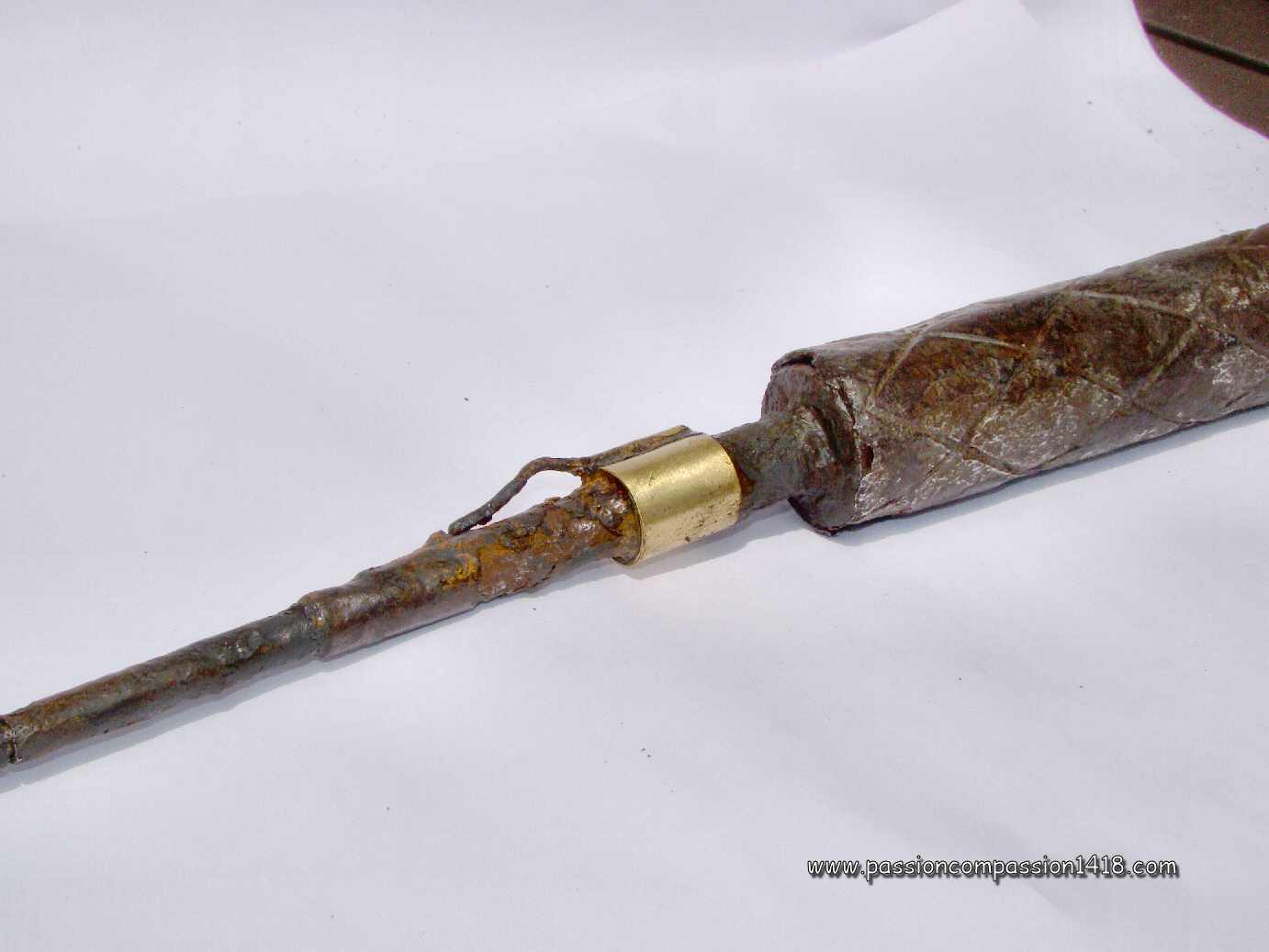 |
|
Feuillette grenade. The triggering tail device, the rod and the hollow aluminium ogive all disappeared. |
Feuillette grenade. Zoom on the triggering device with the rope hook. |
 |
|
Grenade Feuillette. |
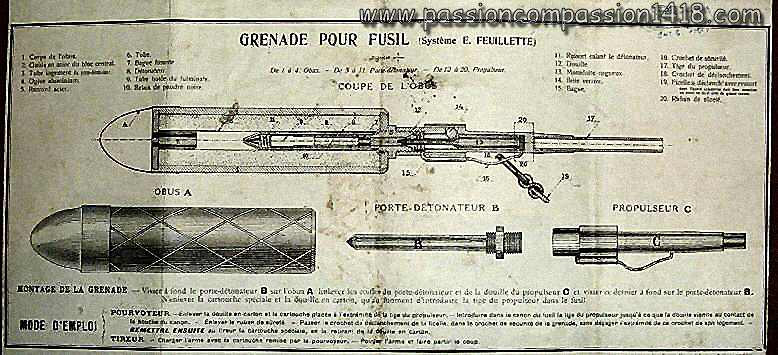 |
|
Feuillette grenade. Wartime scheme. |
|
|
Return at the top of the page |
VB Grenade
Viven Bessière explosive grenade
|
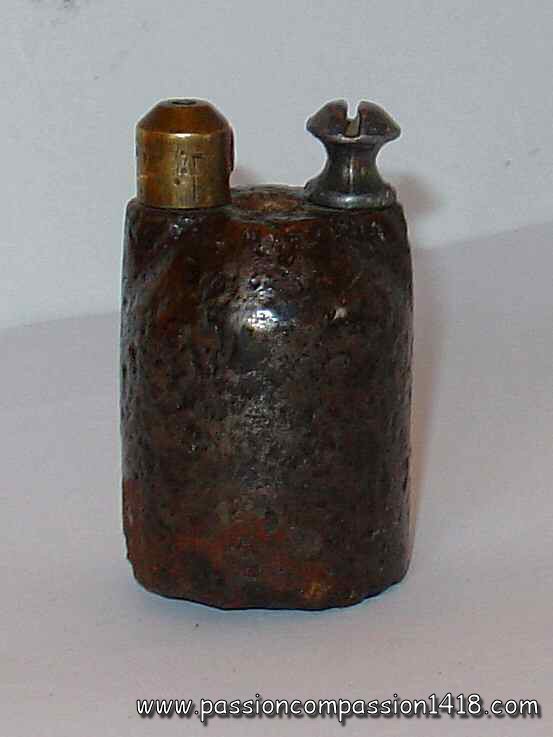 |
 |
The VB (Viven-Bessière) grenade, appearing in 1916, was the most famous and best French rifle grenade.
Made of a pig iron cylinder with inner fragmentation grooves, it was axially crossed by a hollow tube of the same inner diameter than the Lebel rifle bullet, laterally by an other tube containing the detonator and parallel to the central one, and was topped by a brass cap with a small lateral percussion lever over the detonator tube as well as filling aperture plug.
The VB grenade was shot using a grenade-sleeve fixed on the Lebel rifle, using a traditional ammunition rather than a blank cartridge, thus avoiding frequent accidents caused by ammo confusion in the fight stress.
When shot, the bullet went through the central tube, hit the small lever placed on the external part of the detonator, igniting the starter that communicated the fire to the wick then the detonator. The ejection gases, accumulating in the sleeve when the bullet was still inside the central tube, propelled the body of the grenade up up to 180 m.
A small brass cap with a central hole for the bullet was sometimes used to cover the external mechanisms and prevent accidental percussion during transportation.
This grenade was so efficient that it changed the tactics of the French infantry. Each company had 16 VB men, giving a powerful and very manoeuverable firepower for both attack and defense. It was still in use in the French Army in 1940.
Weight 475 gr., including 60 gr. cheddite
|
Rifle grenade Vivien Bessières - At the right side, igniter cover (the small lever has disappeared). At the left side, screw closing the filling aperture |
Rifle grenade Vivien Bessières - Igniter cover and screw dismounted, at the middle notice the channel for the rifle bullets |
 |
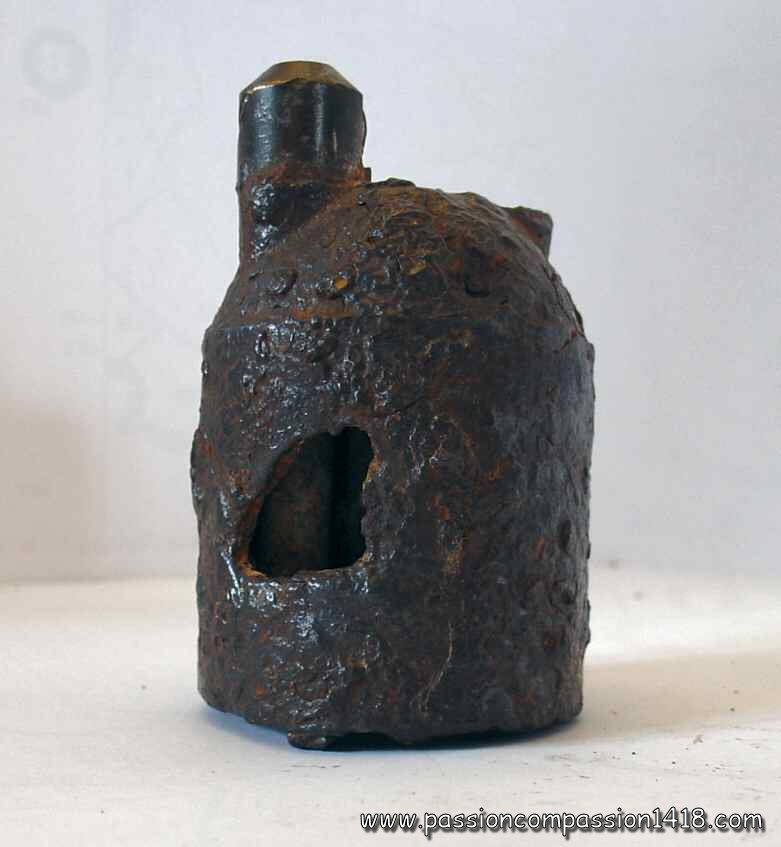 |
Rifle grenade Vivien Bessières - Base view with the rifle gun bullets channel |
Rifle grenade Vivien Bessières - I bet this one did not hurt anyone... (observed on the 'Chemin des Dames') |
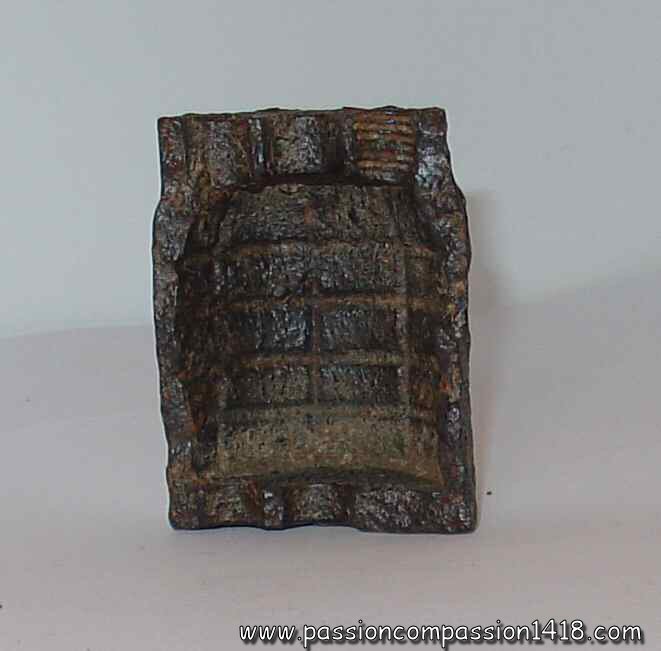 |
 |
This other one, hopefully cut in two by a deficient fragmentation, show us its inner grooves (observed on the 'Chemin des Dames'). The central tube and detonator tube both disappeared. |
Nice item with markings 'TS' and the original triggering lever |
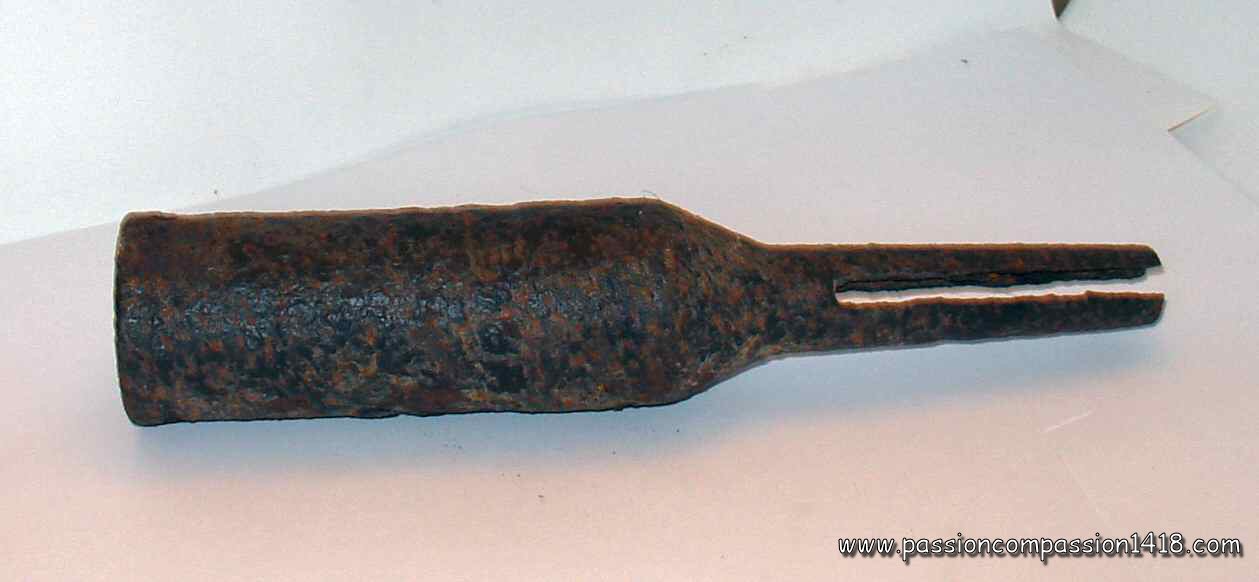 |
Adaptable launcher for shooting the Vivien-Bessière Grenade with the Lebel Rifle |
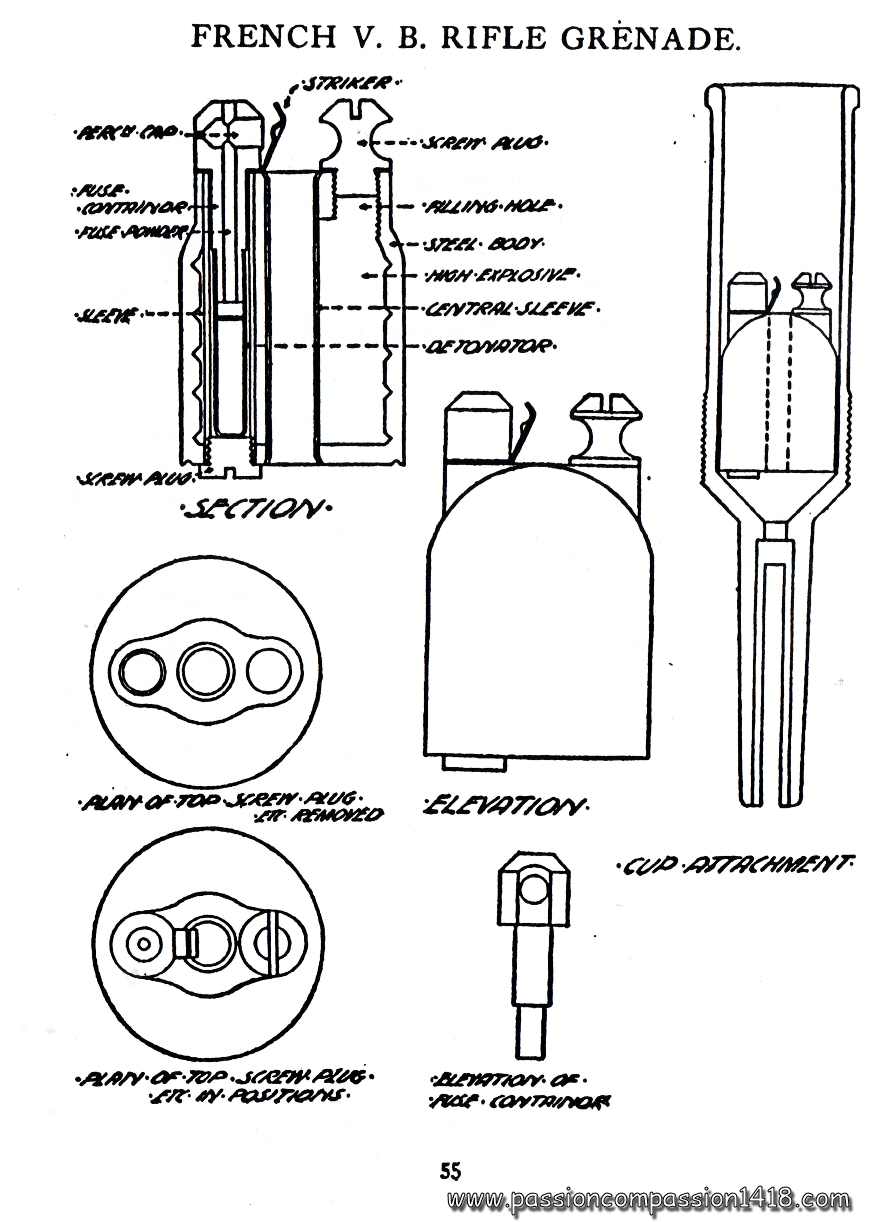 |
 |
|
Grenade VB - wartime scheme |
Grenade VB - wartime scheme |
|
|
Return at the top of page |
Pig Iron lighting grenade
|
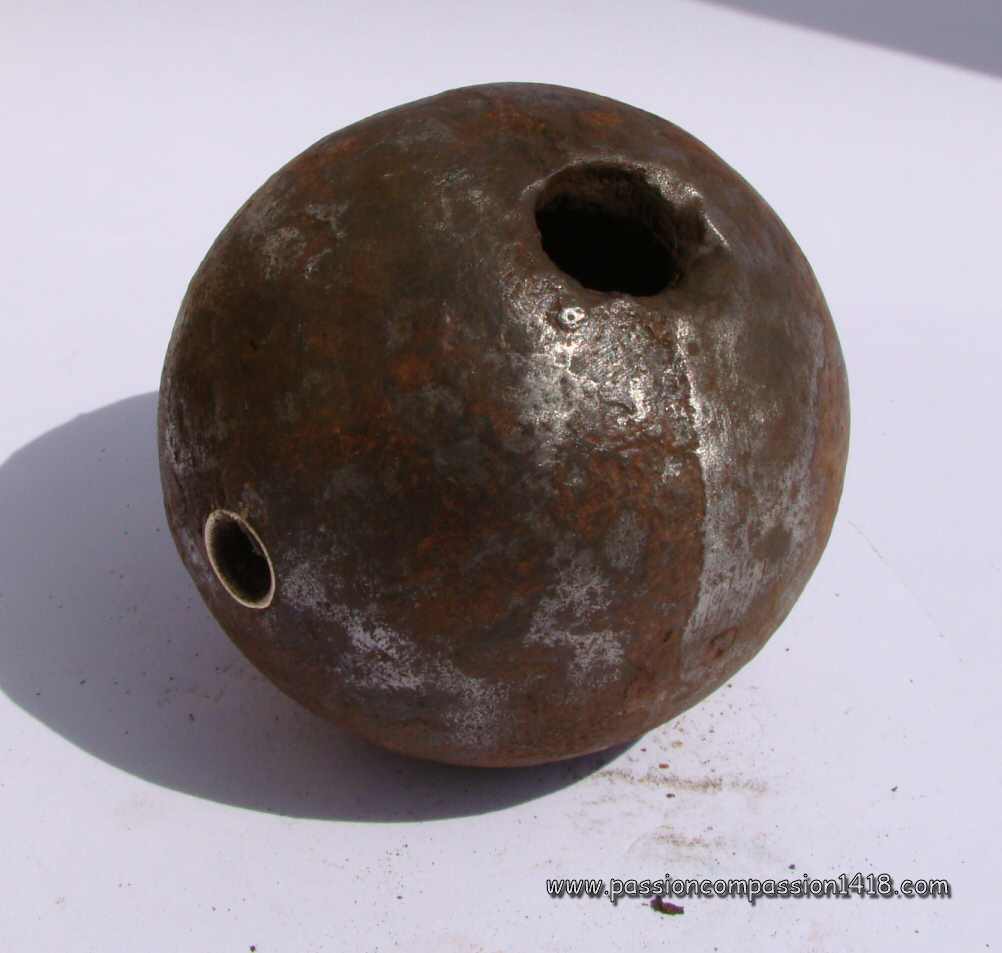 |
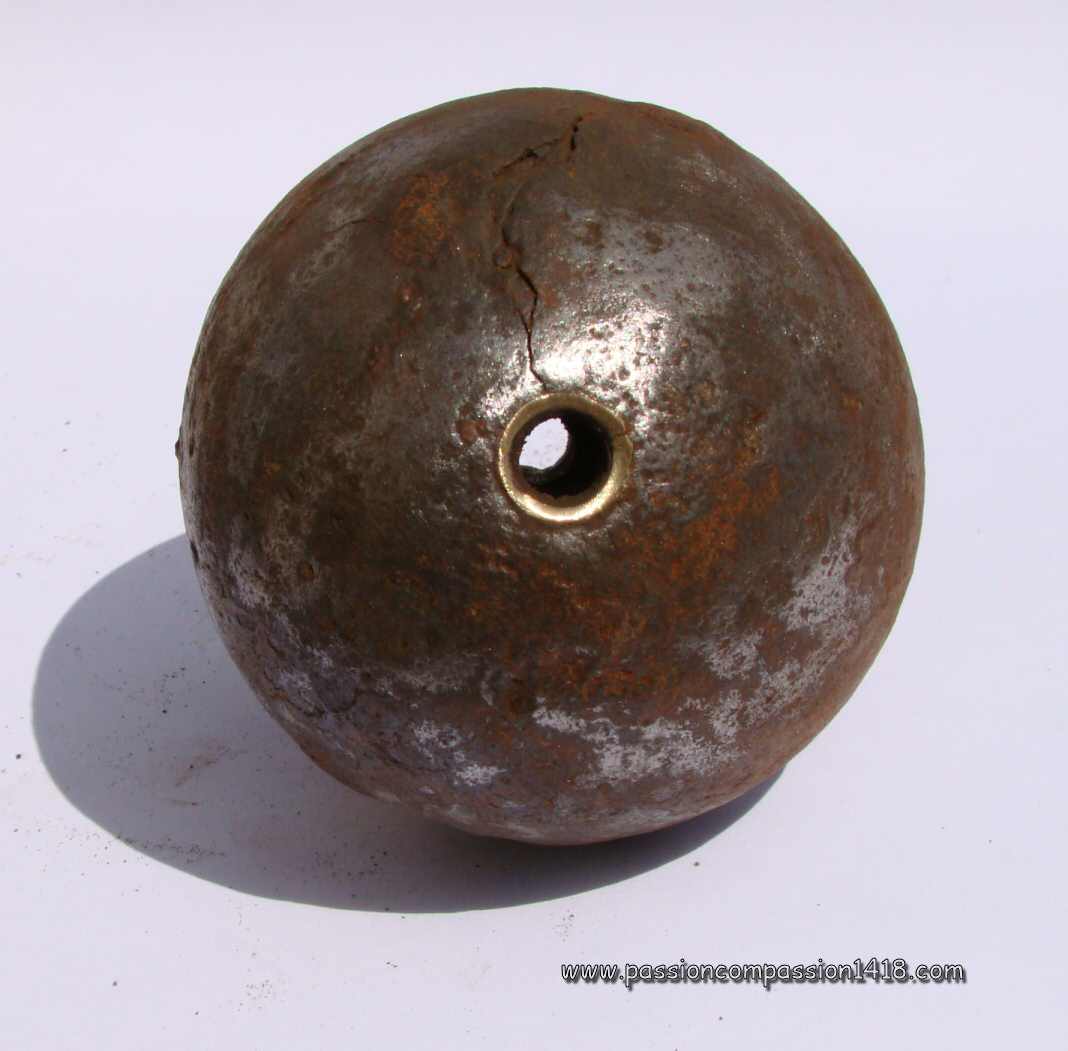 |
Lighting grenades were usually used in defensive actions to reveal the approaching enemies at night, or even to blind the defenders during night assaults.
The characteristics of this Pig Iron lighting grenade are unknown, but it seems it is a model from the middle of the XIXth century. It was a casting sphere drilled with 4 holes, probably closed by wooden plugs. One of the holes was used for inserting the friction igniter. Another bigger one probably was used for filling with the lighting material. The role of the two last ones, facing eachother and joined by an inner tube is unknown.
Unknown weight
|
Pig Iron lighting grenade. Big filling hole, and one of the two ones linked by a tube. These ones seem to be protected by a brass-like material. |
Pig Iron lighting grenade. Sight across the inner tube linking two of the 4 holes |
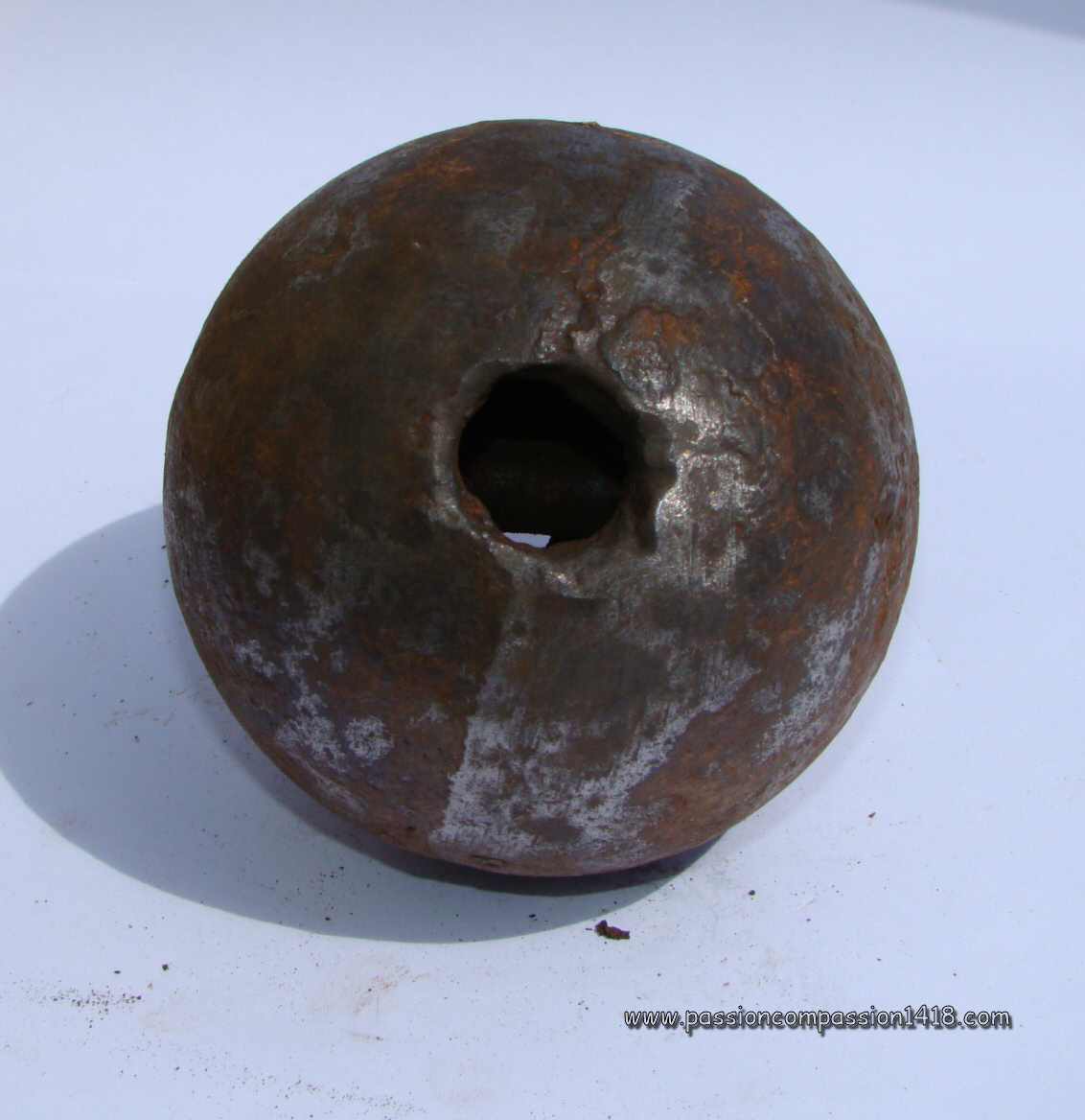 |
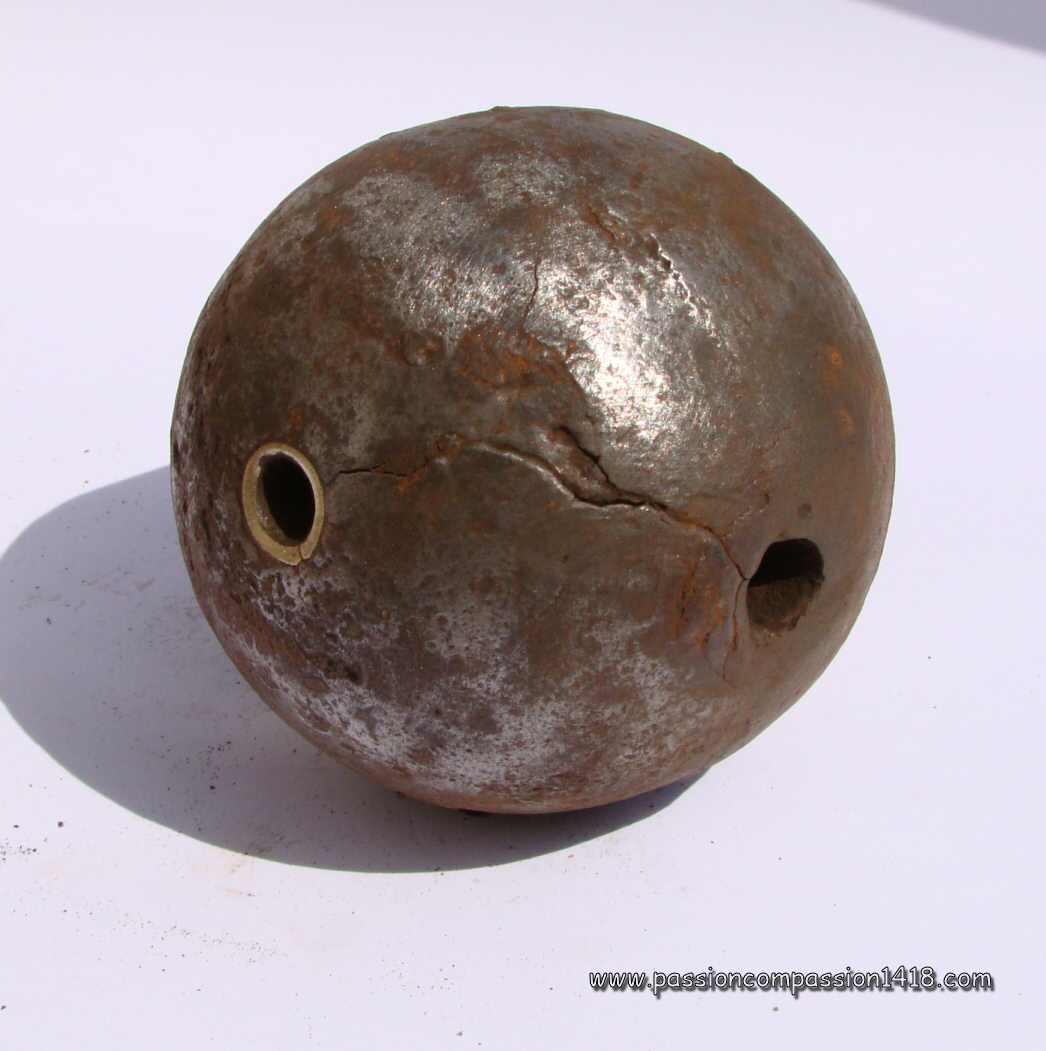 |
Pig Iron lighting grenade. Zoom on the filling hole (?) |
Pig Iron lighting grenade. At the right, the smaller of the 4 holes, that was probably used for the friction igniter. |
|
|
Return at the top of the page |
Suffocating grenade model 1916
|
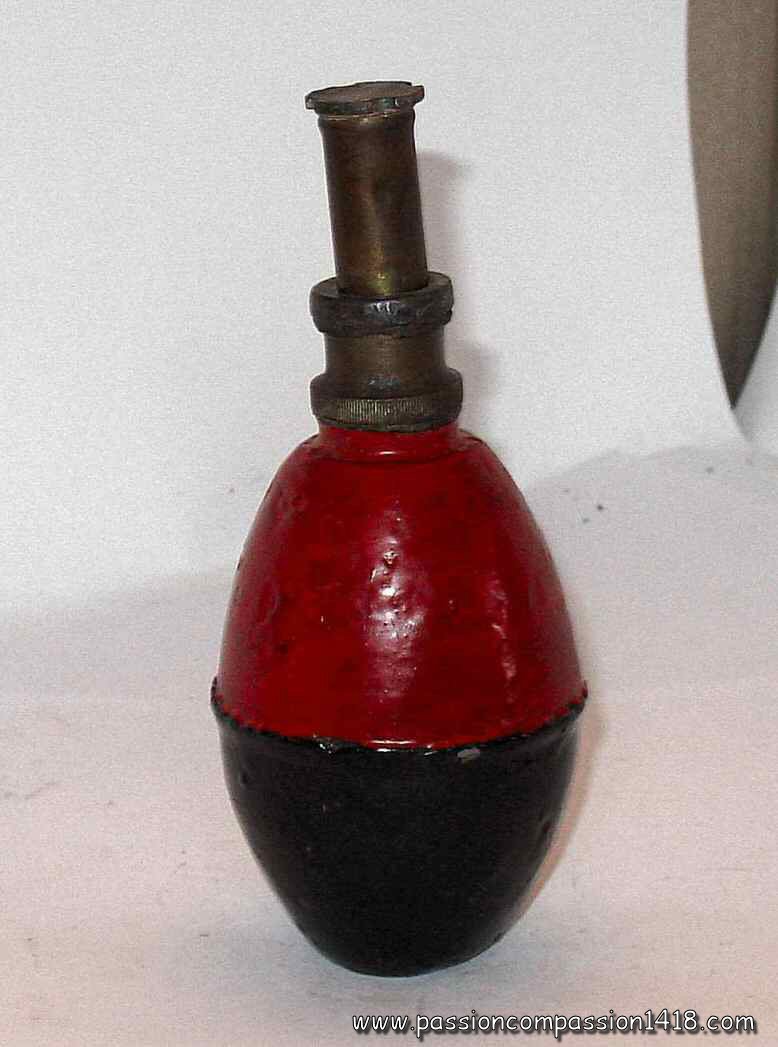 |
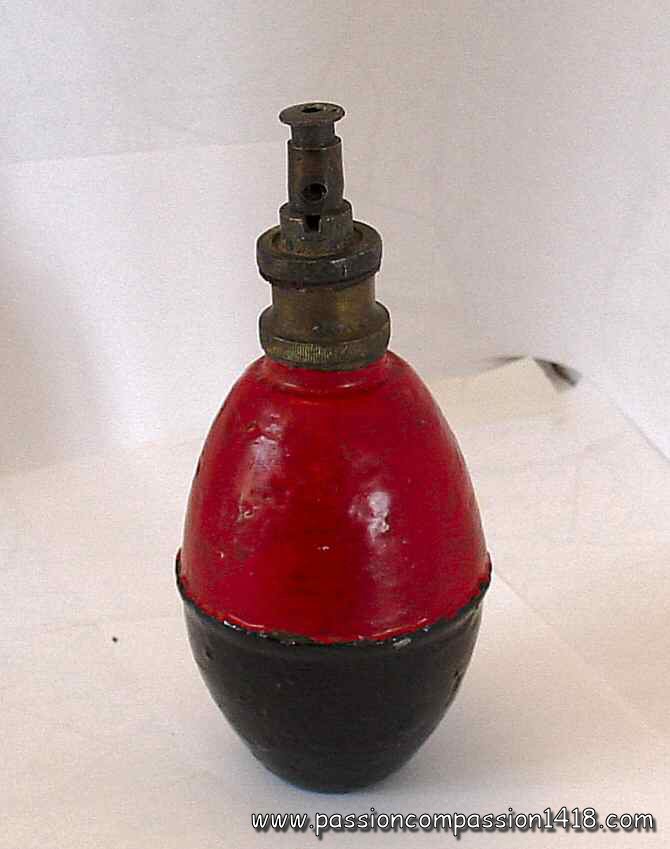 |
Several kind of suffocating grenades were already in use in the French police before the war.
In 1914, a grenade Suffocante modèle 1914 is introduced. Its ovoid profile, initally made of brass with an inner tin cover (in order to resist to the irritating liquid corrosion), then of iron with an inner lead cover (for the same purpose) contains the tear gas liquid. A color code designated the leaded iron models (upper body painted in red) from the tinned brass ones (red belt on the plug).
In the middle of the war an evolution appeared : the grenade Suffocante modèle 1916, identical to the first one, but equipped with an brass thread adaptator to allow the use of modern ignitors, including the automatic igniting plug Billant (model 1916 B).
Weight 400 gr., including 200 gr. of tear-gas liquid
|
Suffocating grenade model 1914 |
Suffocating grenade model 1914, protection cap removed, ready for ignition by percussion |
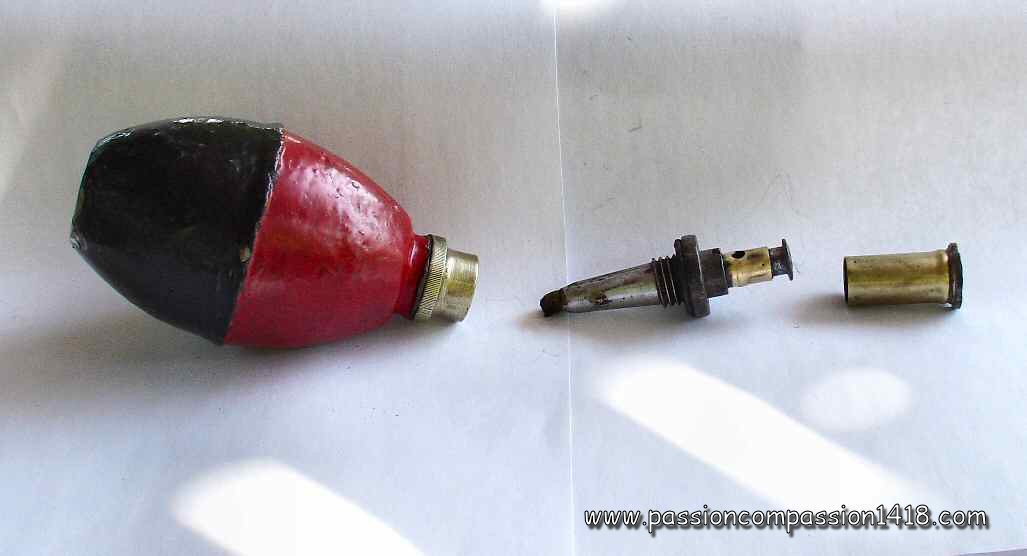 |
Suffocating grenade model 1914, dismantled, with its percussion igniter |
|
|
Return at the top of page |
Suffocating grenade Bertrand model 1915 and 1916
|
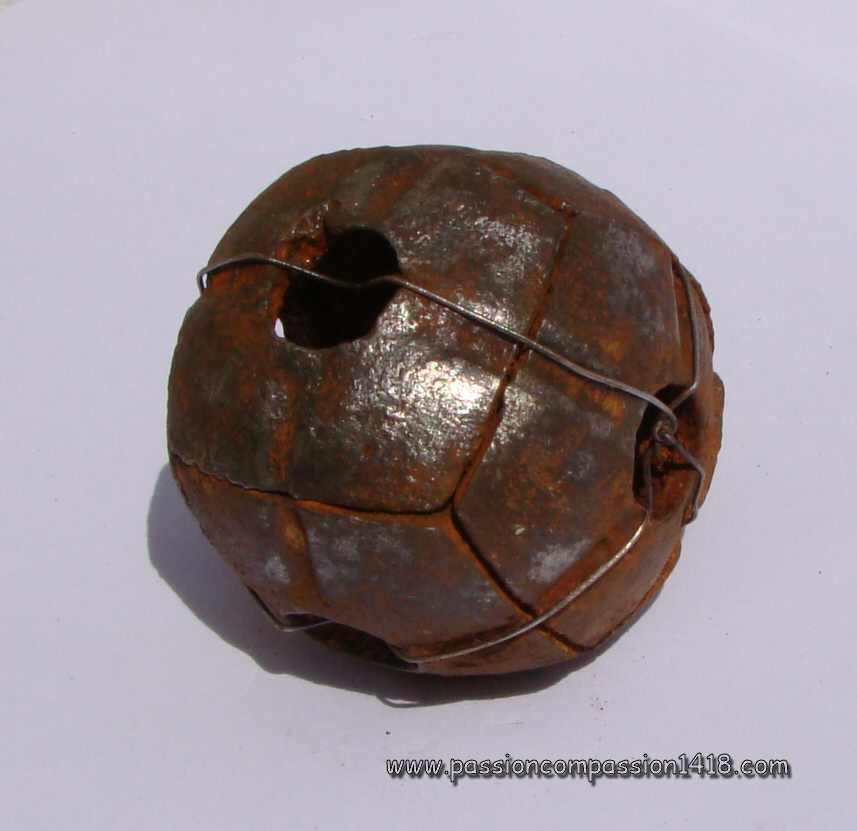 |
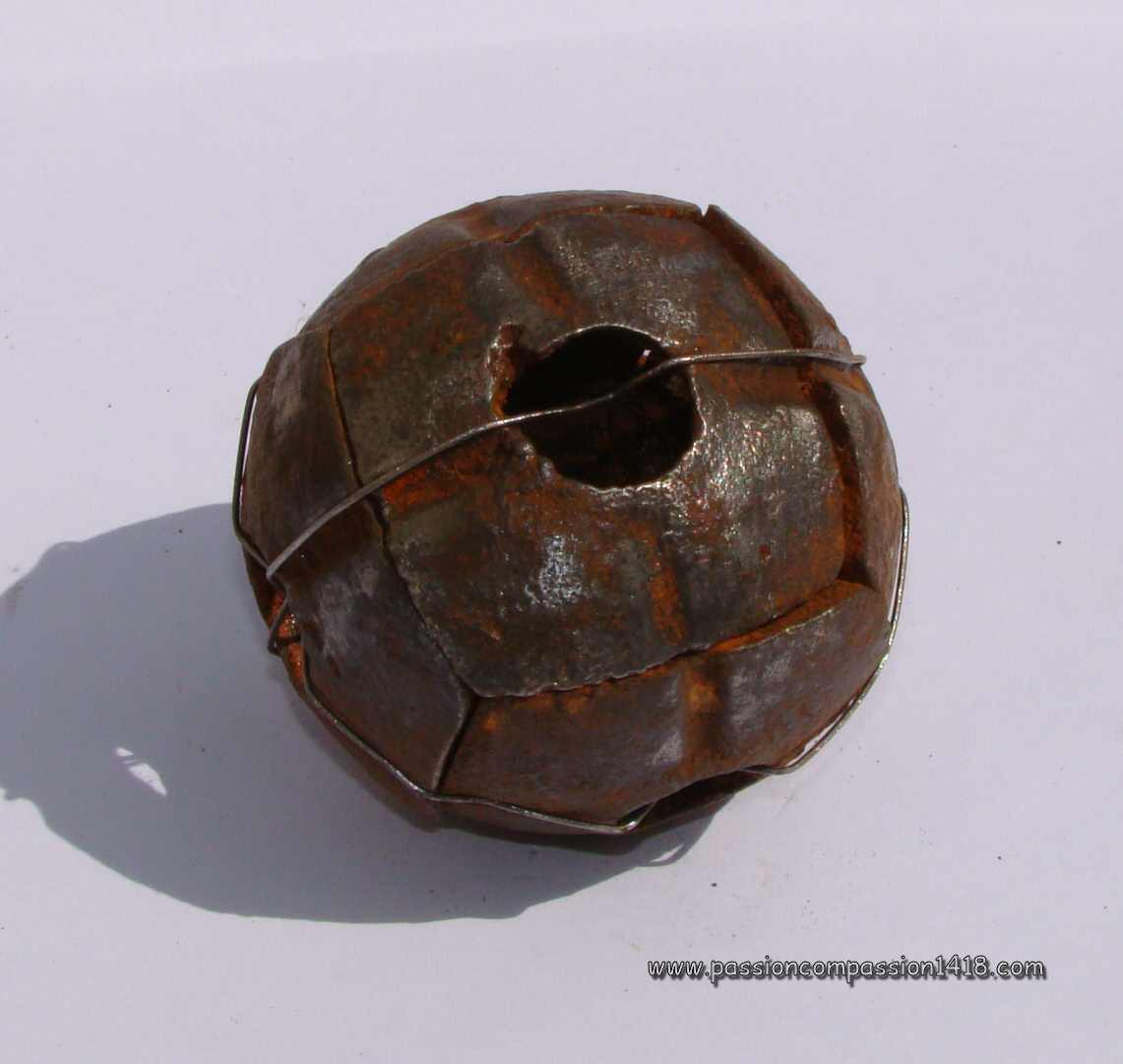 |
Made of 6 pig iron chips, each of them drilled with a hole and having 4 pins on their inner side, assembled together with a steel wire and wrapping a spherical glass bulb containing chloracétone, the grenade suffocante Bertrand modèle 1915 is a 6cm sphere that just needs to be threw against a hard surface to diffuse its tear gaz.
The idea was certainly good, since it was sparing the use of ignition plugs, and since the use of such suffocating grenades was interesting to oust the ennemies from dug outs. But the realization was affected by design defects, such as the low quantity of active liquid (25 gr), and particularly the bulb fragility that made it frequent to be broken in the soldiers bags.
As a consequence, even if huge quantities of these weapons have been produced during the war, the French soldiers often got rid of them as soon as possible, judged by the big numbers of these grenades found after the war in the rear lines or the communication trenches going to thye first lines.
In 1916, a grenade suffocante Bertrand modèle 1916 having twice the diameter of the first one was produced in small quantities in order to increase the quantity of diffused gaz.
Weight 200 g (model 1915), including 25 g of tear-gas liquid
|
Suffocating grenade Bertrand model 1915 |
Suffocating grenade Bertrand model 1915 |
|
|
Return at the top of page |
Brandt pneumatic mortar grenade
Brandt mortar 1915 A projectile for 60 mm pneumatic mortar
|
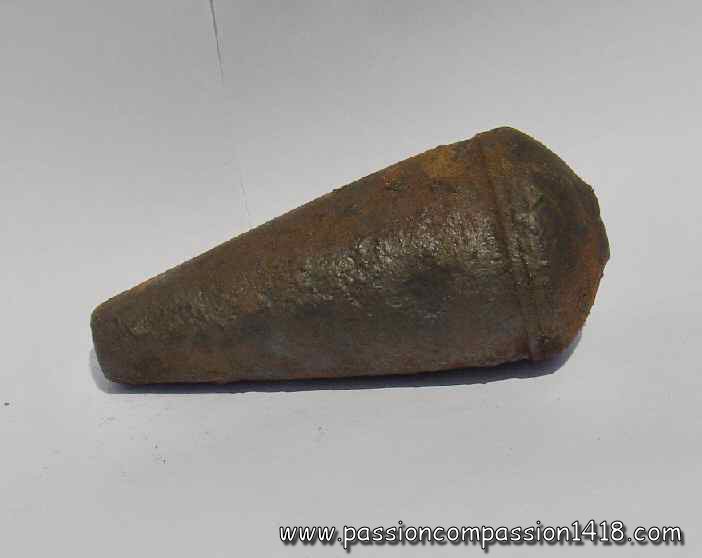 |
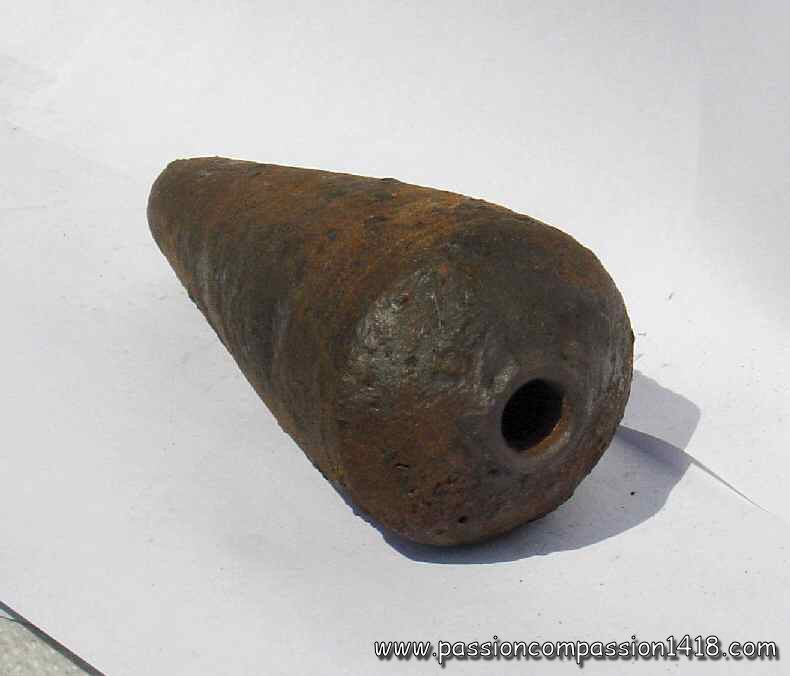 |
The choice to classify the projectiles of the small trench launchers is all mine and could be challenged. In this arms domain, WW1 was the time of a very creative activity. Amongst these original weapons one can find the pneumatic mortars, silent and mobile, but not very powerful. On the French side, the most developped model is the 60 mm pneumatic mortar Brandt, appearing as soon as the end of 1915.
The launcher tube was 1m30 long and had a 60 mm calibre, linked to a system of tanks, pistons and mobile breech (total weight 22 kg). A 3-legged craddle, weighting 16 kg could be mounted. The compressed air was either coming from bottles, or made locally with manual pumps
Initially developped as a pneumatic grenade-launcher, this mortar eventually received specific projectiles, with a small winged tail screwed at the bottom of the cone. There were the 60 mm explosive projectiles A shell 1915 (950 g) and B shell 1916 (650 g), with inner prefragmentation grooves and a percussion fuze with safety pin.
The mortar could also fire lighting, message-bearer or chemical (glass body) winged projectiles.
Weight 950 g including 120 g cheddite (Model A 1915)
|
Brandt mortar 1915 A projectile observed in Champagne. The wings have disappeared. |
Brandt mortar 1915 A projectile. Percussion fuze room. |
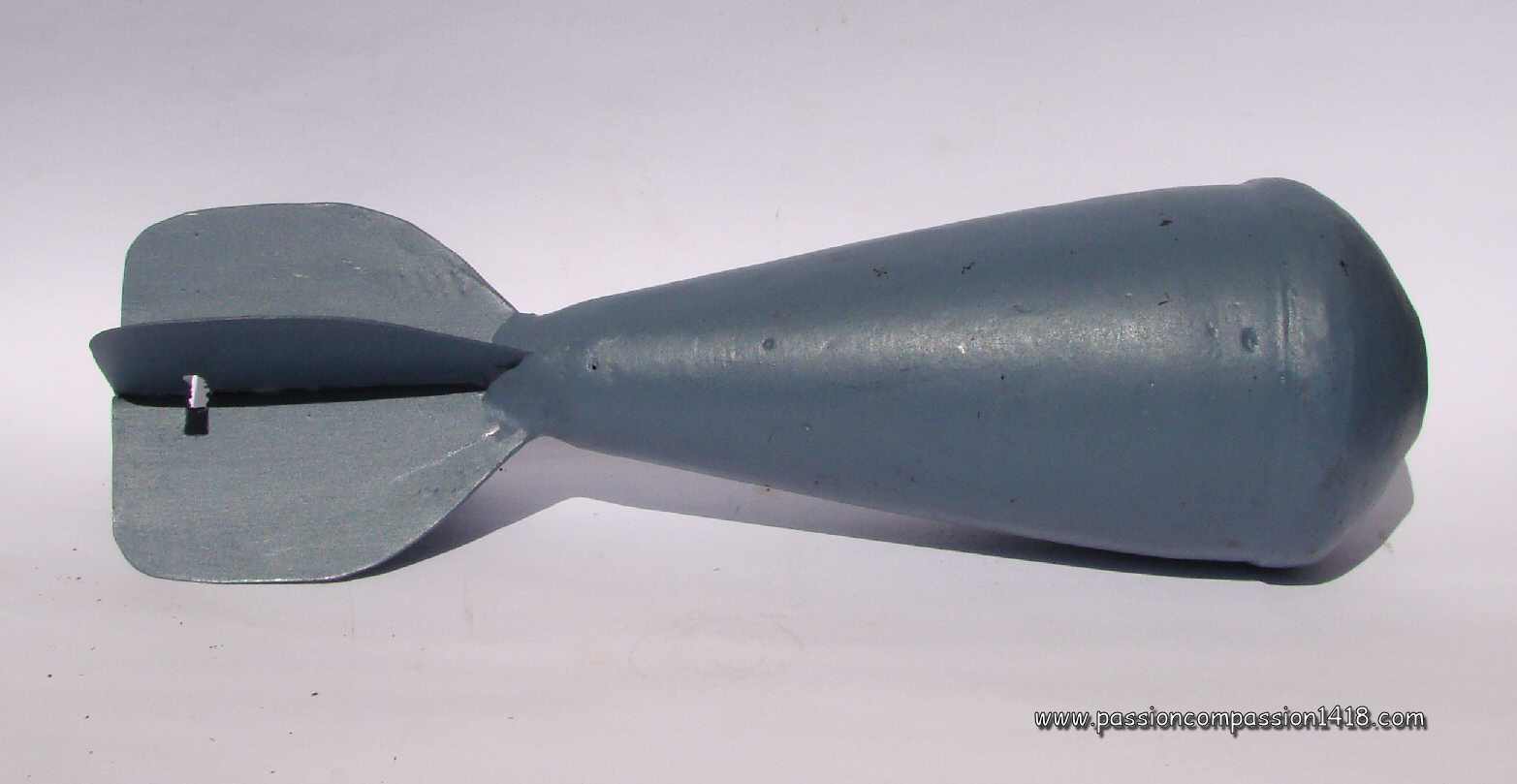 |
|
Brandt mortar 1915 A projectile . |
|
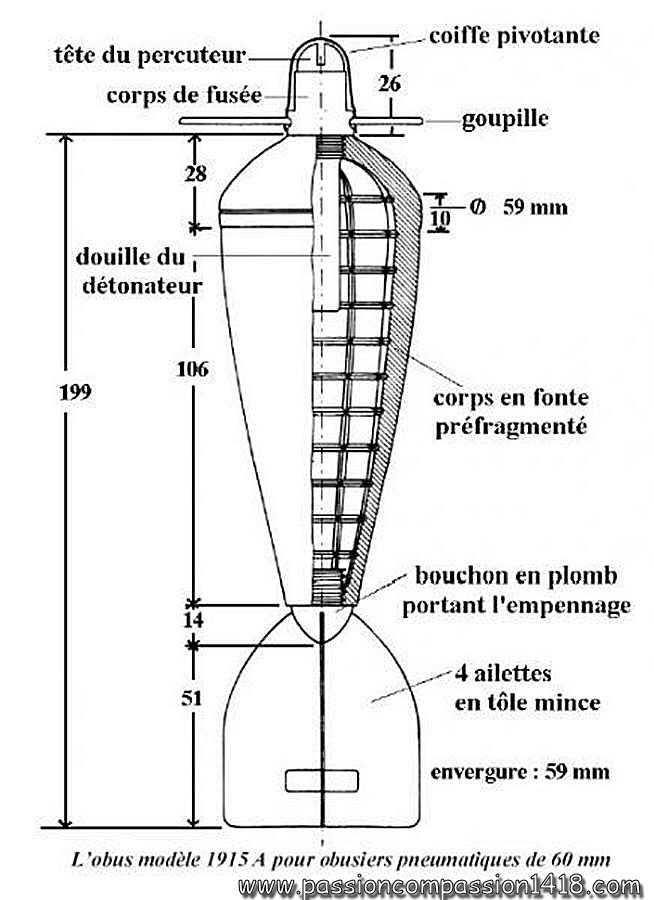 |
 |
Brandt mortar 1915 A projectile - Scheme. |
Brandt mortar 1916 B projectile - Scheme. |
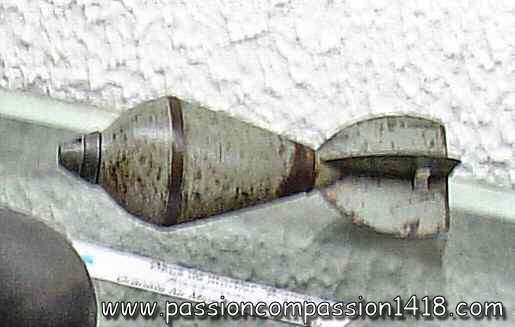 |
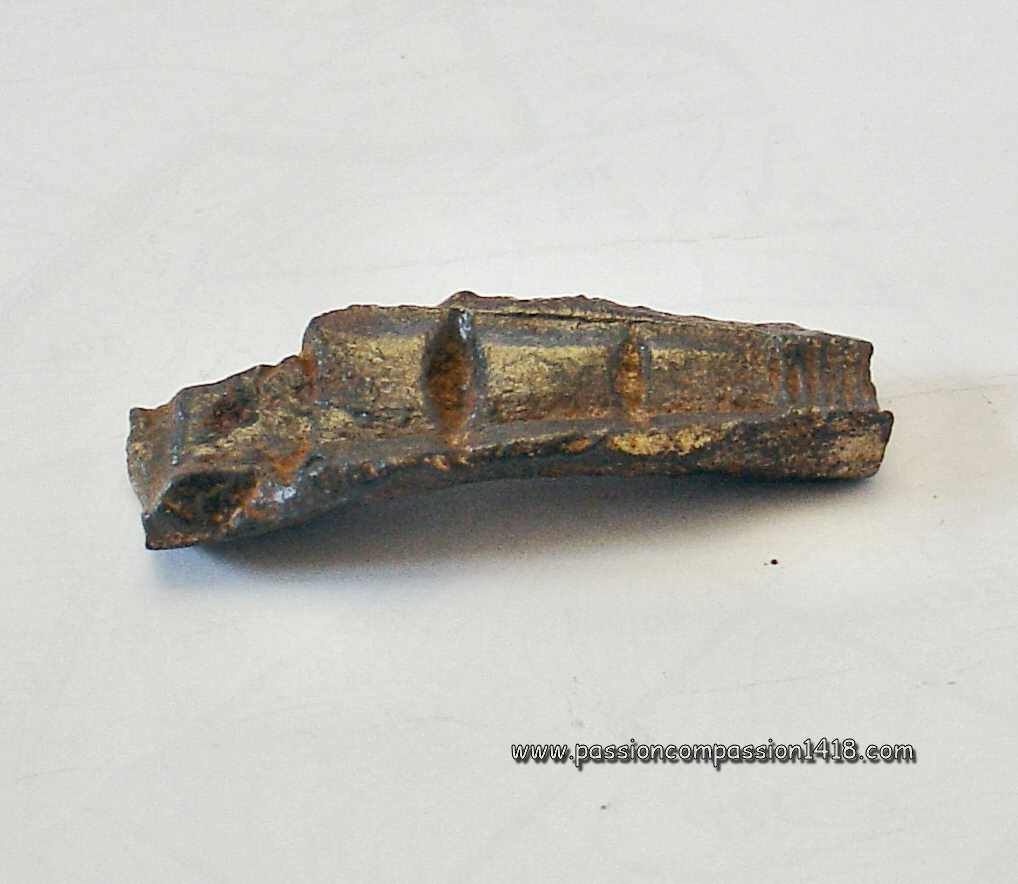 |
Brandt mortar 1916 B projectile exposed in Albert (Musée des Abris). |
Brandt mortar 1915 A projectile. Shrapnelle observed in the Chemin des Dames showing the inner fragmentation and the thread for the winged tail |
|
|
Return at the top of the page |
Model 1916 DR grenade
|
 |
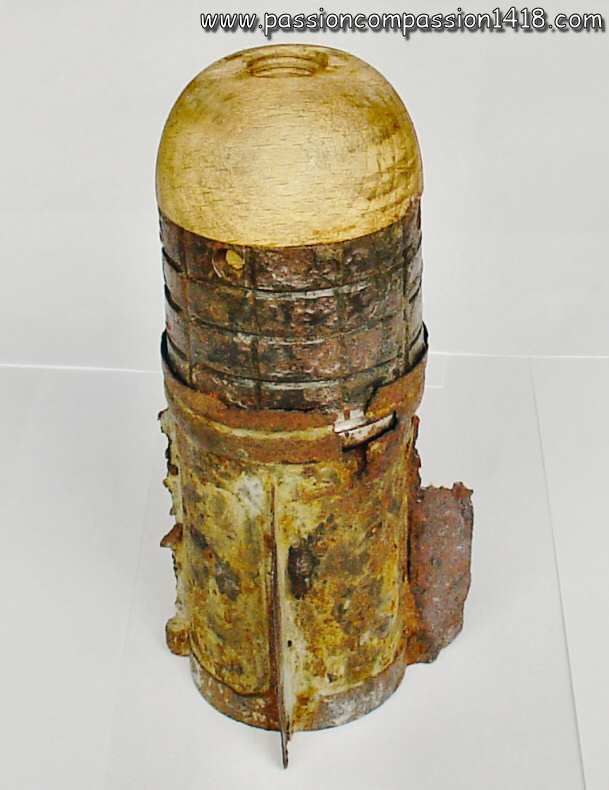 |
The DR grenade appeared on the front lines at the end of 1916. It was designed to be shot by an infantry rifle covered by a grenade-sleeve with variable room volume and armed with a blank cartridge.
Composed of a crimped thin steel sheet base wearing wings, a pre-fragmented crimped thicker steel sheet body, a wooden detonator-bearer head, that grenade never really went satisfactory because of the difficult development of its percussion detonator, causing eather unwanted explosions at the departure, or uncertain explosion at the arrival.
That projectile was also used on 'bombardes Garnier', made of 4 assembled guns of 'Gras' rifle, equipped each of two grenade-sleeves, in order to fire 8 grenades at the same time.
Weight 550 g, 85 g cheddite |
DR grenade in relatively bad condition, traces of original kaki paint on the body |
DR Grenade, the wooden detonator-bearer head is not the original one |
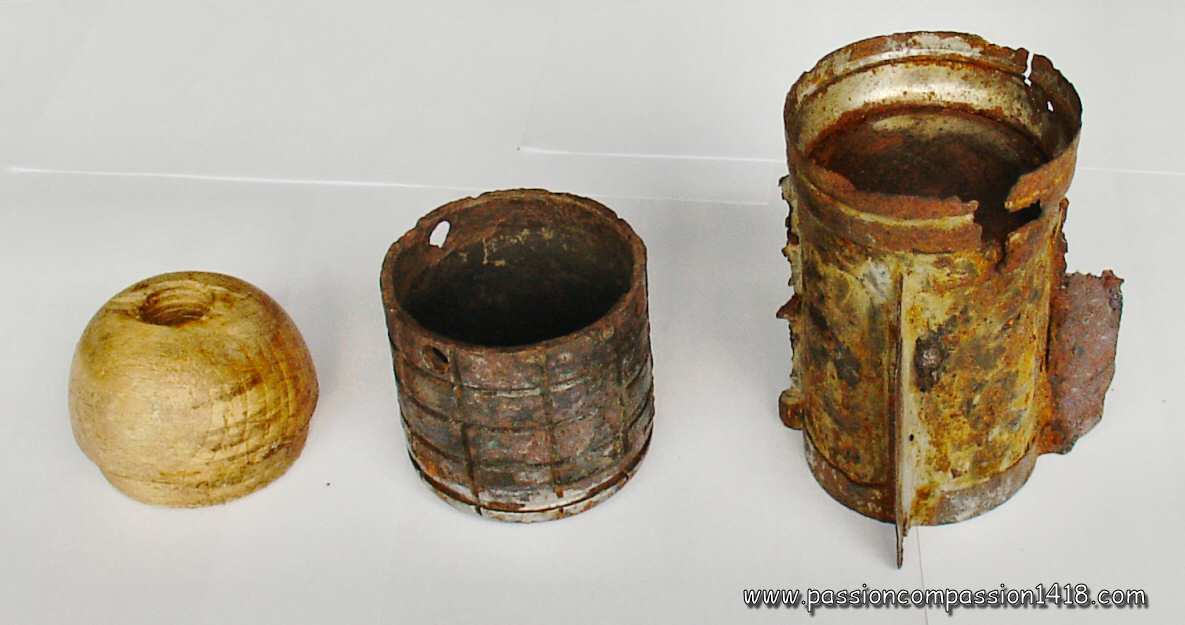 |
Dismantled DR Grenade |
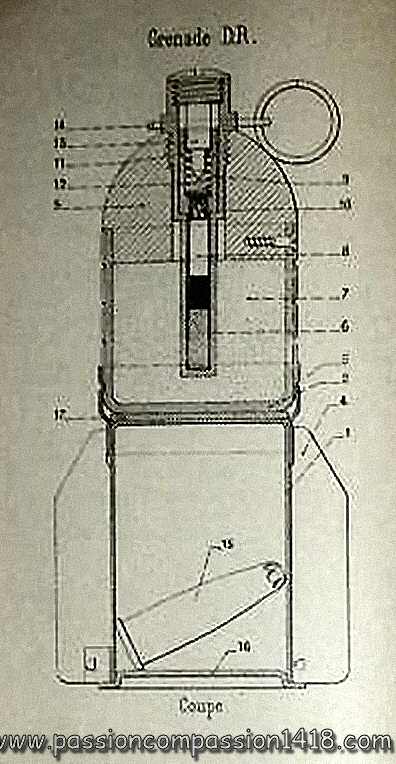 |
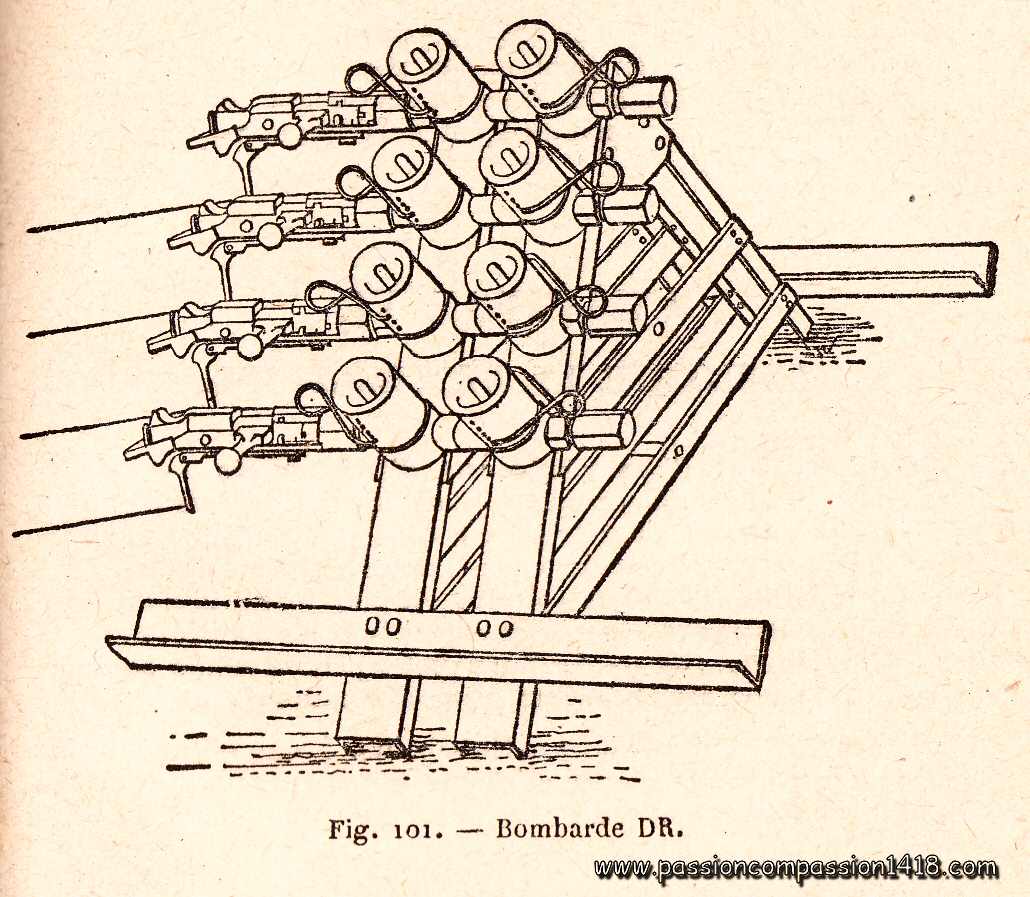 |
DR grenade - wartime scheme |
DR launcher - wartime scheme |
|
|
Return at the top of page |



































































